This picture-perfect Paris Brest filled with creamy, nutty praline mousseline cream is a showstopping, delicious French choux pastry dessert!
With this foolproof, step by step recipe and guide, you too can master this classic French dessert with ease. I’ll show you how to get those perfectly-shaped choux pastry rings filled with a rich, praline-flavored creamy filling.

Why you will love this recipe
- Paris Brest may seem like something only pastry chefs would attempt to do, but I break it down step by step in this recipe so that it’s super easy to follow.
- I provide the best choux pastry troubleshooting guide on the internet on this web site. Many have had great first time success with my choux pastry guide, which will help you make this Paris Brest recipe with ease too.
- I explain how to make the rich mousseline cream, with different flavor variations.
- In this post, I explain why Paris Brest pastries fail, common mistakes, and share plenty of expert tips on how to perfect them.
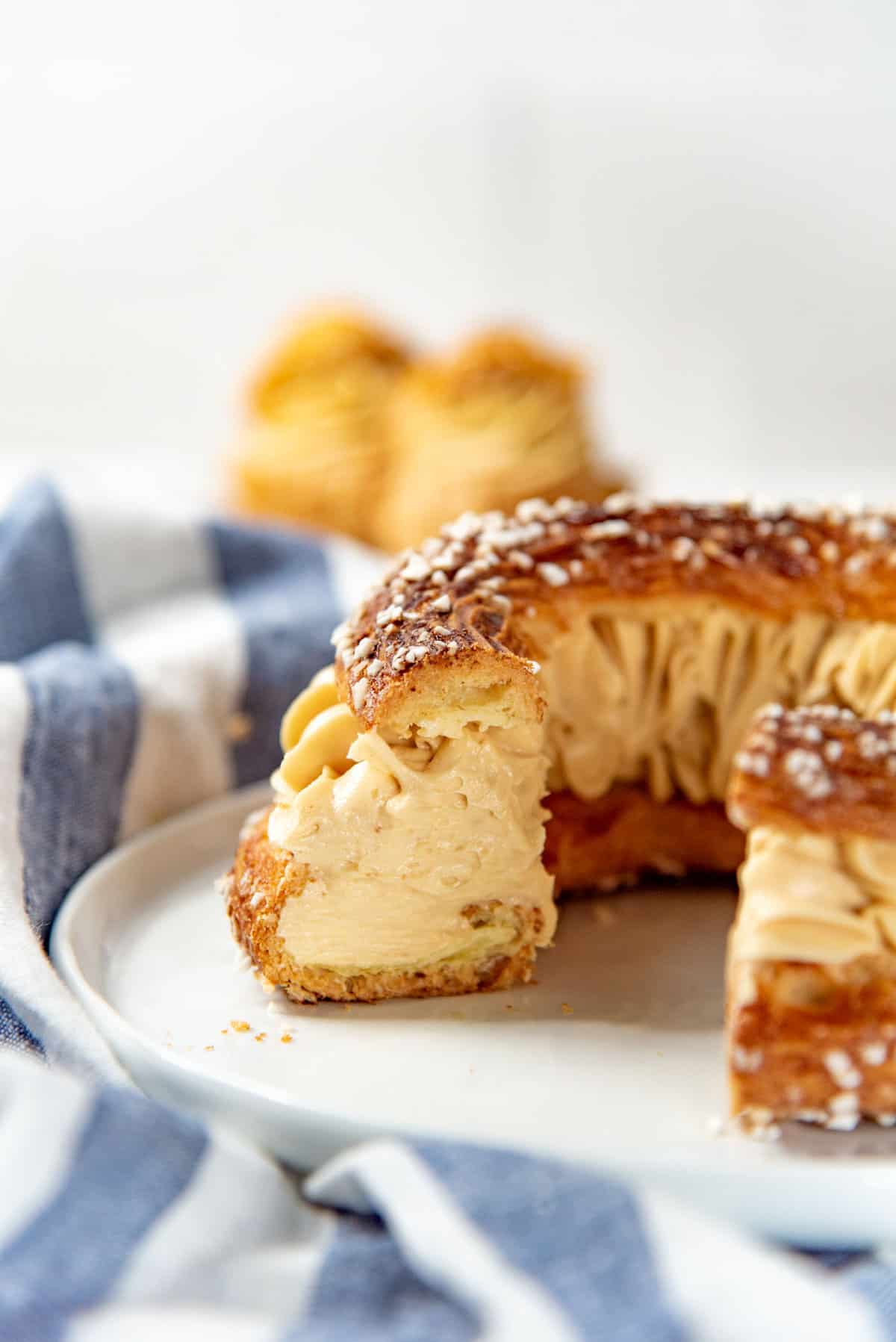
What is Paris Brest?
Paris Brest is a French dessert made with choux pastry and a praline mousseline filling. The pastry was first created in 1910 to commemorate the Paris-Brest-Paris long-distance bicycle race which began in 1891. The idea was for it to resemble a bicycle wheel, hence the circular shape of the dessert. And as you may have guessed, it’s named after the French cities of Paris and Brest.
This dessert is not for the faint of heart, because it’s a rich, buttery, and sweet pastry that has creamy, caramel, nutty flavors. It’s so delicious and a wonderful treat worthy of any special occasion!
Components of a classic Paris Brest
A classic Paris-Brest is a pastry made with choux pastry and filled with a praline mousseline cream. To make this dessert, you need 3 components.
- Choux pastry
- Praline paste (almond praline or hazelnut praline or a mix of both)
- Mousseline cream (A custard whipped with butter)
Here’s how to make each of these components.


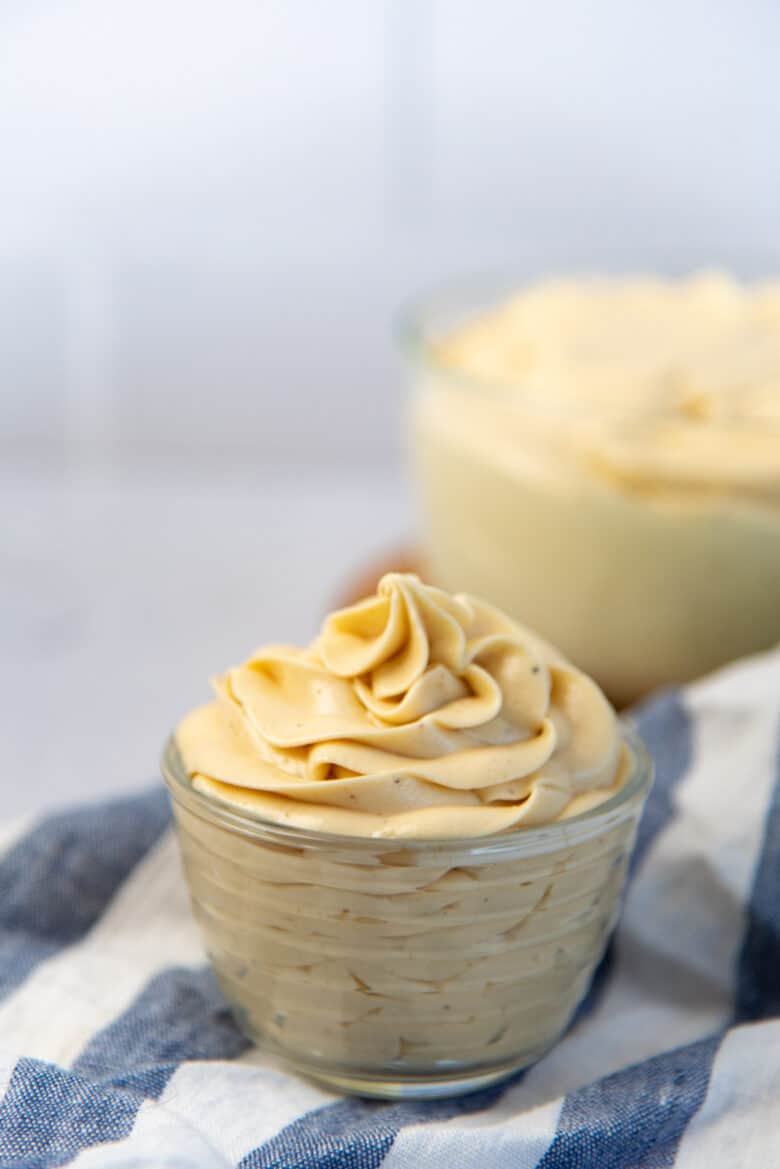
Ingredients to make Paris Brest with Praline Crème Mousseline
Choux pastry ingredients
Water or milk
This is the base for choux pastry dough. Milk makes the pastry softer, while water allows the choux to be a little more firm. Milk also adds a little extra flavor, but I prefer to use water. Milk or water evaporation is what makes the choux pastry rise.
Butter
Butter is the main ingredient that adds flavor to the dough, but also helps to soften the dough. You can use vegan butter or oil as a substitute to butter.
Flour
I use all purpose flour in this recipe. You can also use bread flour, which will result in a thicker, sturdier shell.
Eggs
Another crucial ingredient, and unfortunately there is no substitute for this. Eggs add structure to the choux pastry (along with the gluten in the flour), and also helps with the rising of choux pastry. However, too much egg will make the choux pastry flat.
Salt and sugar
Salt and sugar add flavor to the dough. Without salt, the choux pastry will taste absolutely bland.
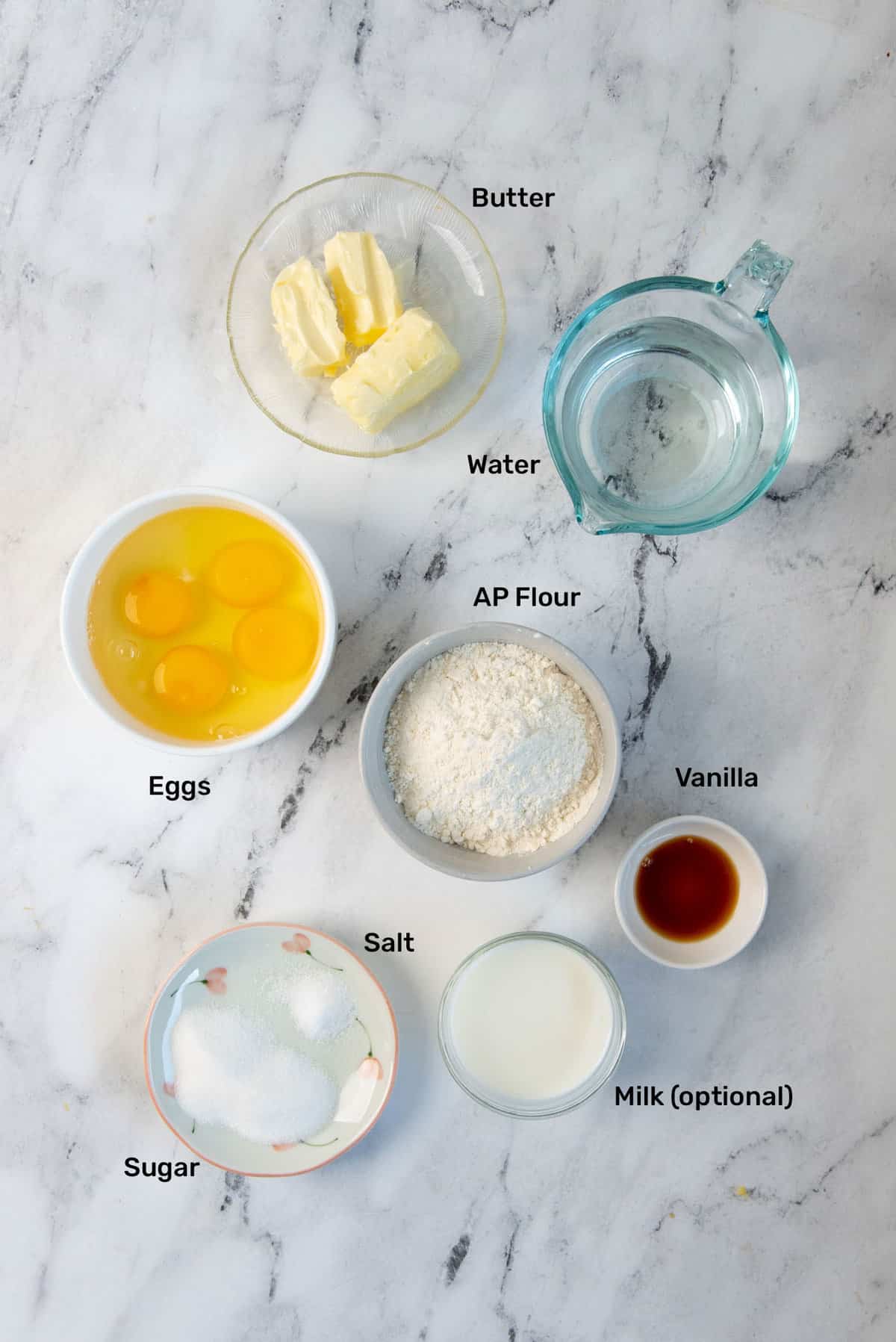
Praline ingredients
You can either make my homemade praline paste, or use store-bought praline paste.
Hazelnut or almonds (or a mix of both)
You can decide what type of praline you’d like to make or buy. The most popular type of praline is hazelnut praline, but almond praline is more widely available. When possible, I prefer to make praline with a mix of hazelnut and praline.
Sugar
Praline is paste made with nuts and caramelized sugar. So sugar is essential for making praline. Use regular granulated white sugar.
Salt
Salt helps to balance the sweetness. This praline paste isn’t salty at all. Just a pinch to balance the sweetness will make this praline cream taste even better.

Praline mousseline cream ingredients
Pastry cream
To make mousseline cream, you first need to make a thick custard, or pastry cream / crème pâtissière (you can check my post to read all about the different types of custard). To make pastry cream, you will need,
- Milk
- Sugar
- Cornstarch
- Egg yolks
- Vanilla
- Salt
Apart from the custard, you will also need,
Butter
I use unsalted butter for this recipe so that I can control the amount of added salt. But you can use salted butter too. Just make sure to adjust the amount of salt added in the custard.
Praline paste
You can make your own praline paste, but you can also buy praline paste from specialty stores. Making your own isn’t difficult at all, but it does require a good food processor or blender.
Cacao Barry hazelnut praline paste is a fantastic brand that you can use for this purpose. You can also use chocolate hazelnut paste like Nutella, but the flavor will be fairly mild in mousseline cream.

How to make classic Paris Brest – step by step instructions
How to make choux pastry dough
Check out my detailed post on how to make choux pastry on the blog. This post includes a step by step explanation of,
- How to make choux pastry dough perfectly.
- What to look for in the dough to make sure you’re on the right path.
- Common pitfalls and mistakes when making choux pastry, and why that happens.
- How to troubleshoot and fix choux pastry.


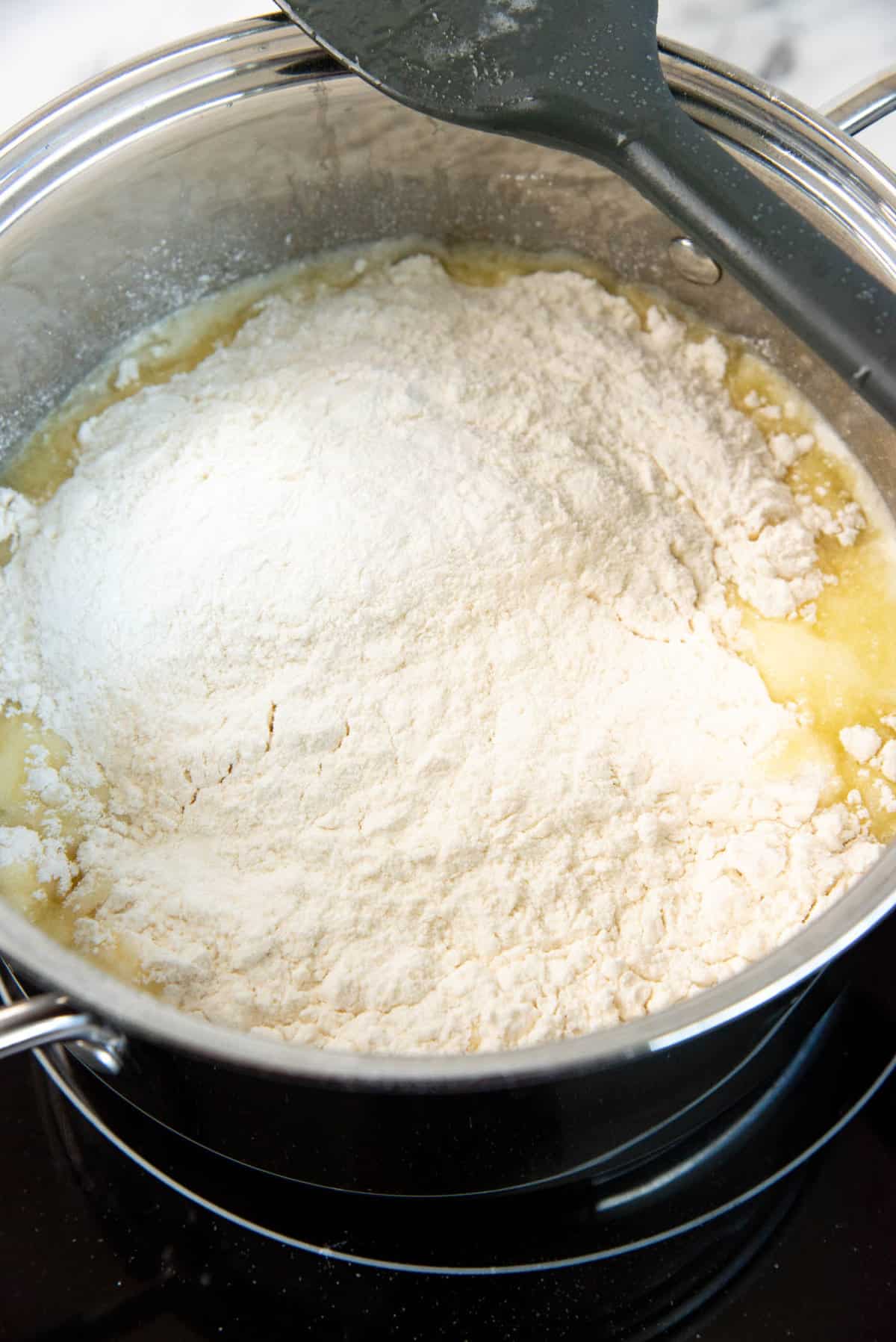

Here are some of the important steps!
First, combine the butter, sugar, salt, and water in a saucepan. Melt the butter, sugar, and salt in the water while heating the saucepan over medium high heat. Bring the water to a boil.
Remove the pot from the heat. Add the flour to the boiling water and stir quickly to allow the flour to absorb the water mixture. Use a wooden spoon or spatula to do this.
Return the saucepan back to low heat, and constantly mix for a few minutes to let some of the water evaporate, until the dough has a mashed potato-like consistency. If you use a stainless steel pot, you will see a film of dough at the bottom of the pot too.
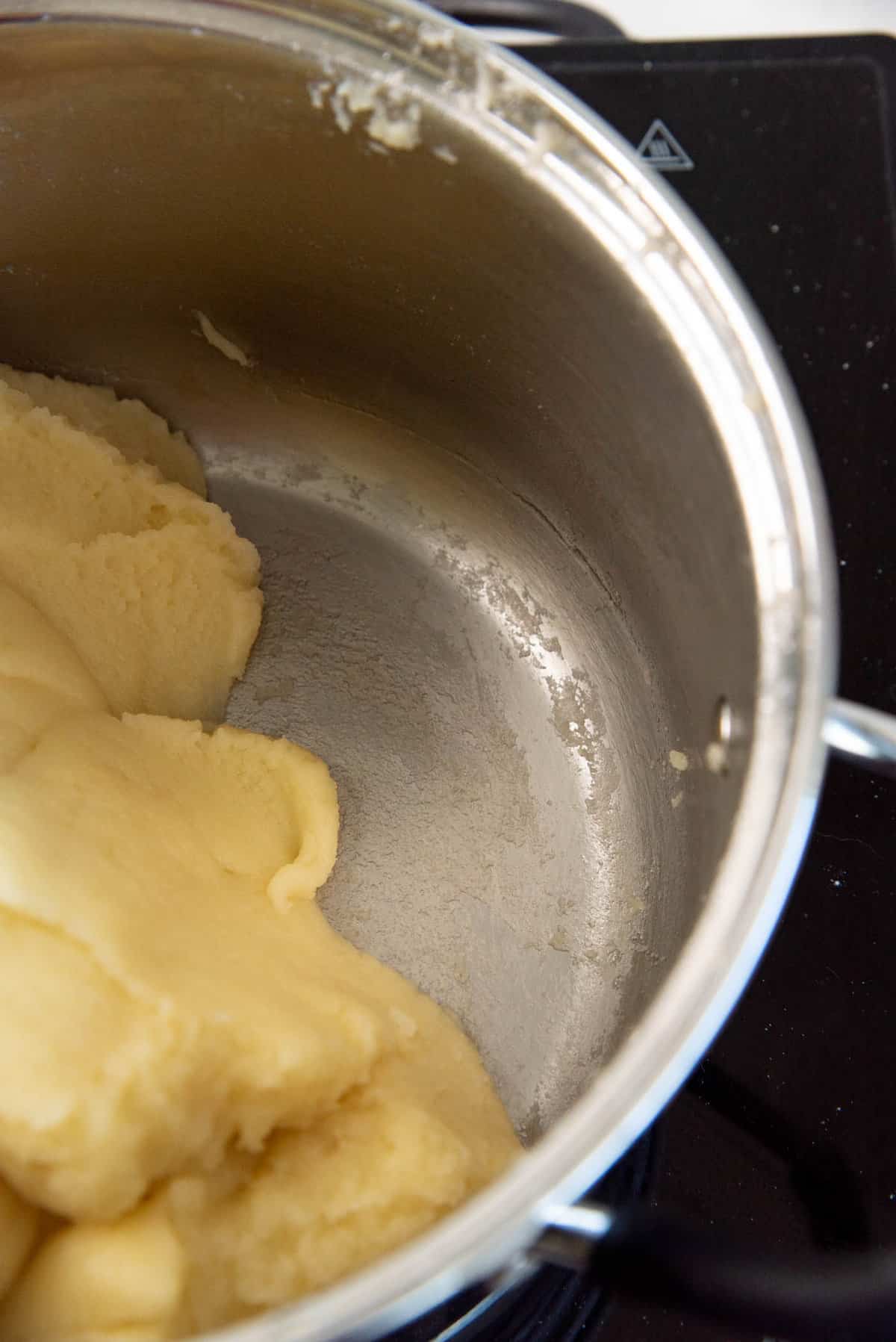

Allow the dough to cool down before adding the eggs. You can keep the dough in the saucepan, or a separate bowl, but make sure the dough is covered to prevent a skin from forming on top.
Beat the eggs in the bowl before adding them to the dough. This is because the amount of eggs that will be added can vary, and you may not need the full amount of eggs noted in the recipe.
Add the eggs, a little at a time, mixing it in each time before adding more eggs. Add only enough eggs to form a dough that has become a little shiny, and is still thick and pipeable. When you lift your spatula from the dough, the dough should form a “V” shape off the end of the spatula (as pictured below).
If you add too much egg, then the Paris Brest will not properly rise in the oven, and will collapse or flatten. Add too little, and the choux pastry will be too dense and will not puff up as it bakes. If you’re having trouble with your choux pastry, please follow my troubleshooting guide for choux pastry.

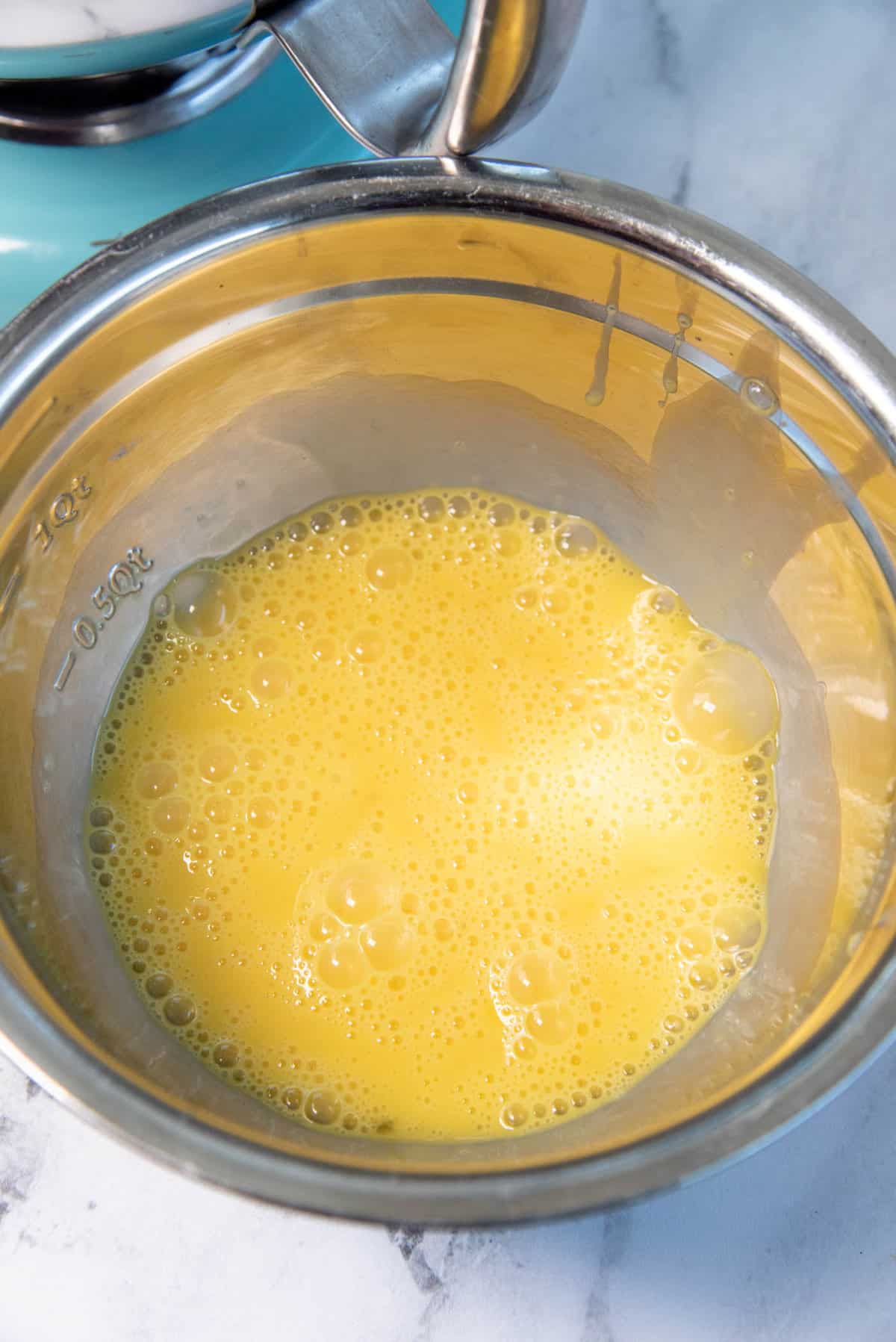
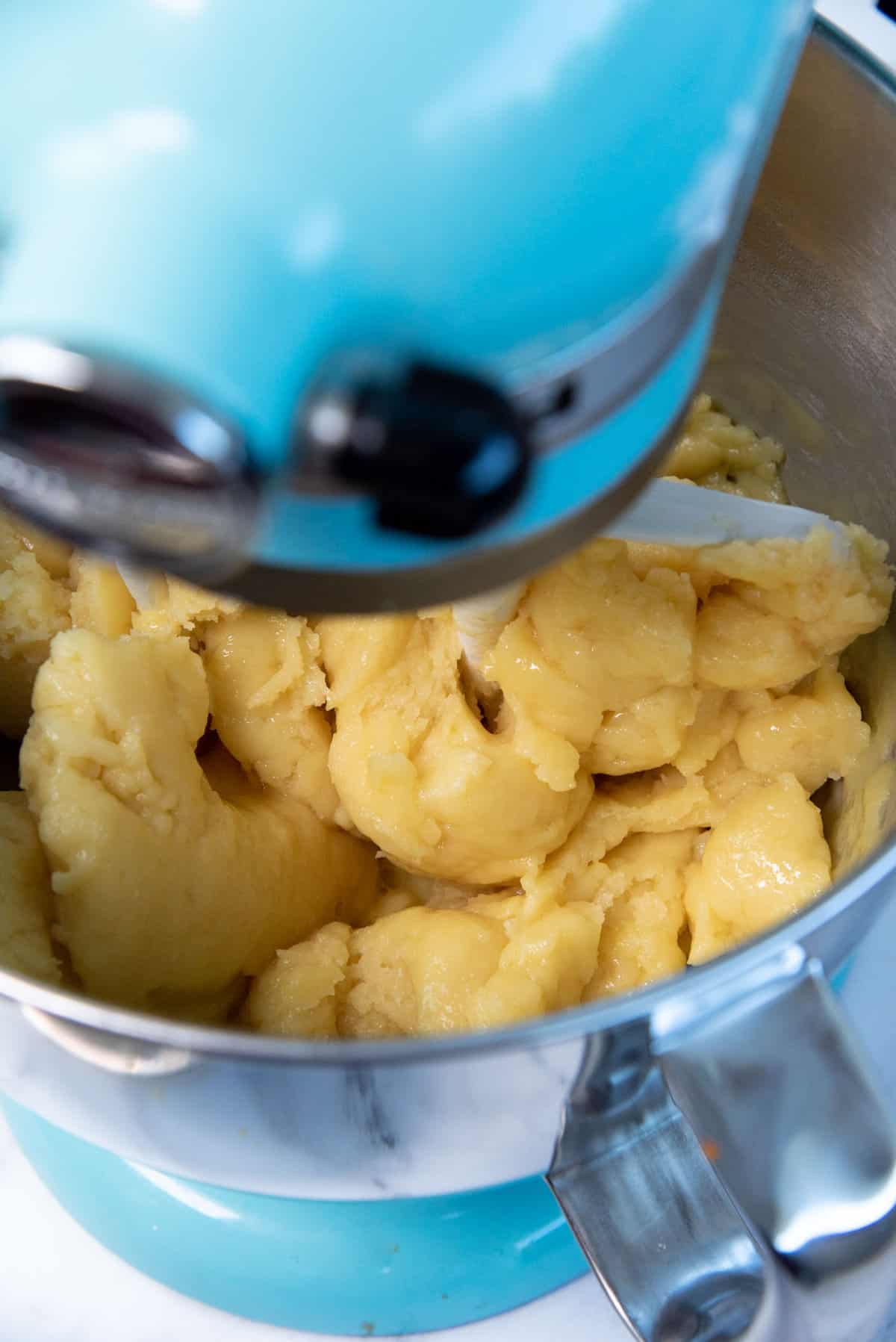

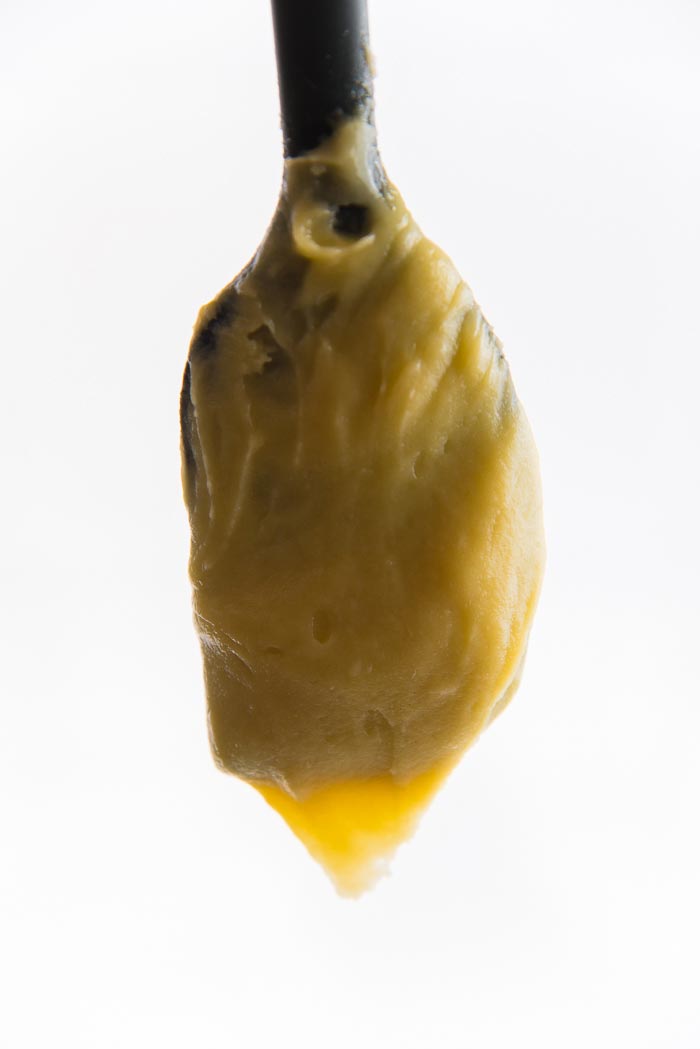
Piping the Paris-Brest shells
Do you find that your Paris-Brest pastry isn’t puffing up as it bakes? Is it collapsing after your bake it?
Or maybe your Paris-Brest pastry is not properly formed and doesn’t have the proper shape as you bake it?
Well, now you don’t have to worry! Here I share ALL the secrets to making perfect Paris-Brest pastries! They’ll be beautifully puffed up, with perfect hollow centers, and won’t collapse or be misshapen either!
Traditionally, Paris-Brest is made by piping 3 dough rings – 2 dough rings at the bottom, and 1 on top. To pipe the choux pastry to make this Paris-Brest recipe, you will need to use two piping tips for best results. You can use round tips or French star tips, and I prefer French star tips. I use Ateco 863 tip and Ateco 865 or Ateco 866 tip.
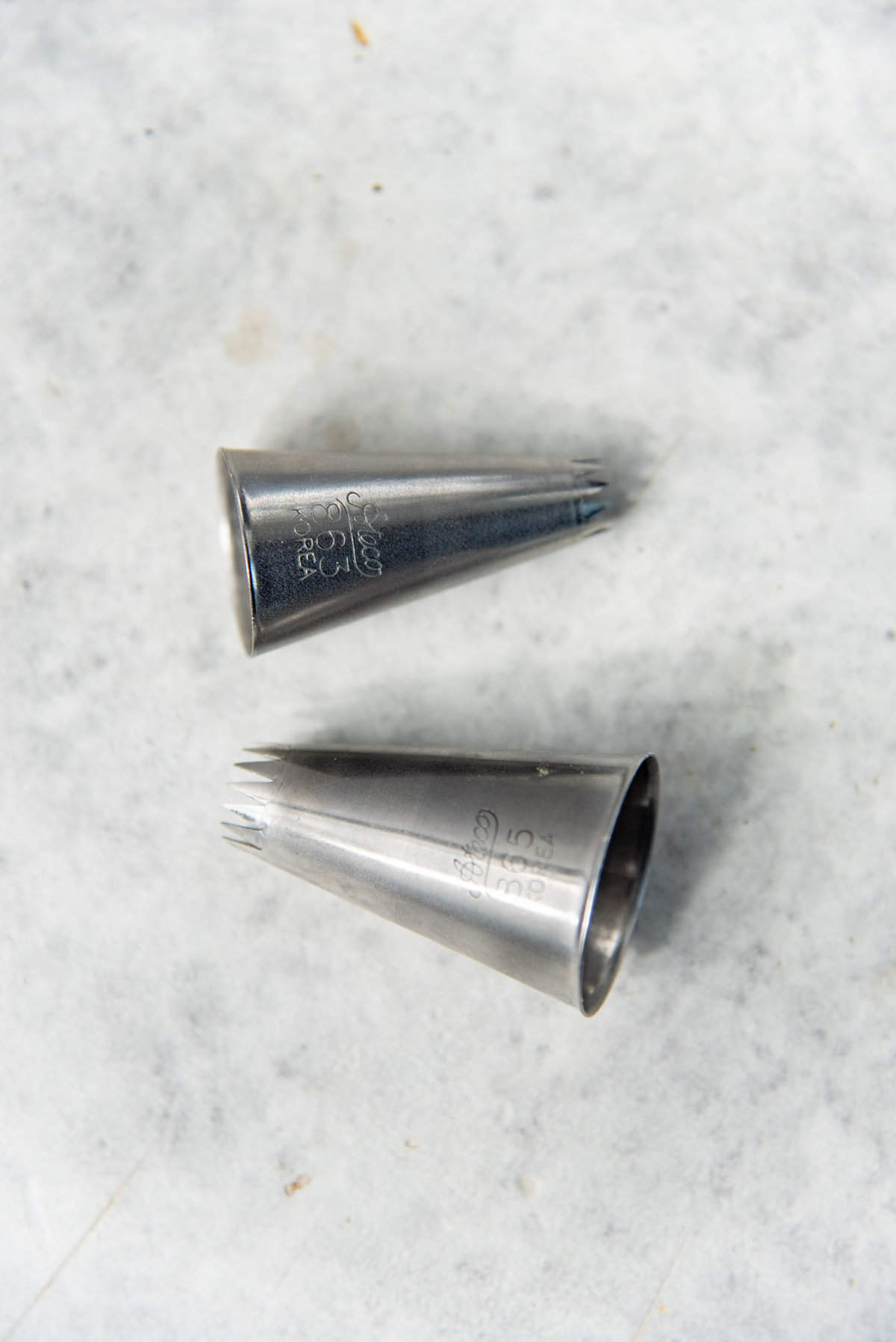
After testing different methods of piping a large ring of choux pastry for Paris-Brest, this is the best combination that gives the most consistent results.
The bottom two dough rings must be piped with a smaller diameter piping tip. The top ring must be piped with a larger diameter piping tip. Much like classic eclairs, the French star tip gives the best results because of the serrated edge creating a pattern on the choux dough for more even expansion. But a plain round tip can also work.
The piping tip with a small diameter – around 0.35 – 0.4 in (9 – 10 mm).
Piping tips with a larger diameter – around 0.5 – 0.6 in (13 – 15 mm).
Draw 5 inch circles on a parchment paper that will fit a half sheet baking tray (see pictures below). There should be enough room for 3 circles. You can either turn this parchment paper upside down, so you can see the marks through the parchment paper sheet, OR place a second parchment paper sheet on top. With both methods you should be able to see the outline of the circles that you drew.
Fill a pastry bag with the choux pastry dough, and snip off the tip. Take another pastry bag and place the Ateco 863 tip in it. Place the pastry bag with the choux pastry dough inside the pastry bag with the piping tip.
Squeeze the piping bag to allow the dough to come out in a smooth, even thickness, over the parchment paper with the outlined circle. Allow the dough to gently pipe down onto the paper, just outside of the outlined circle. Be careful not to pull away the tip too fast to stretch the dough, or to move too slow and allow the dough to bunch up.
Next, pipe the dough again right alongside the piped circle of dough, but this time on the inside. Make sure the dough is piped very close together and the two rings are in contact with each other.
Now you should have two choux pastry dough circles piped right next to each other. Repeat with the other two circles on the parchment paper as well.
Next, take off the outer piping bag with the piping tip. Remove the 863 piping tip and replace with the larger piping tip. Place the choux pastry dough bag inside the piping bag again.
Now pipe one circle of dough on top of the two circles that you piped earlier. Make sure that you pipe the dough the same way, with even pressure, so that the dough will be an even thickness throughout – i.e. not be too stretched or bunched up. This final circle of dough should be placed on top, in between the first two circles.
Dip your finger in cold water and use your dampened finger to gently press down the dough seams so that they flatten and seal. Repeat with the other two dough rings.


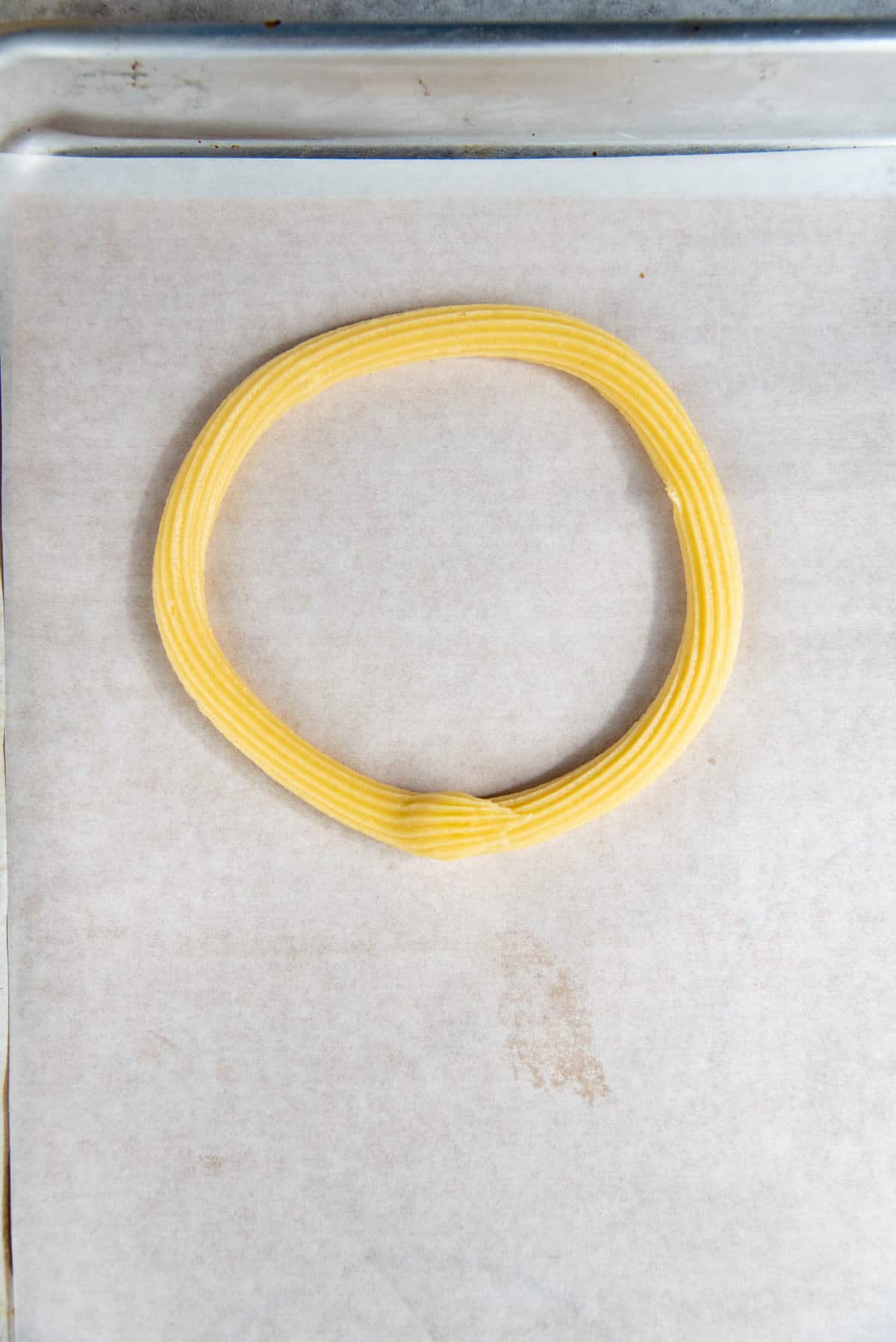



Baking the Paris-Brest pastries
Just like my profiteroles and choux pastry recipe guide, I bake these Paris-Brest pastries at the same oven temperature throughout. So you don’t need to increase and then decrease the temperature between separate batches that are being baked. I promise you, that you will get consistently perfect results this way, because I’ve been making choux pastry since I was 10 years old, literally many thousands of times now, and have perfected my method.
Preheat your conventional oven to 375 F / 190 C. Make sure the oven is preheated at this temperature for at least 15 minutes (longer if you have an older oven). Place your baking rack in the middle of the oven, or where ever you get even heat from both the bottom and top elements in the oven.
ONLY bake one tray at a time to ensure that your choux pastry bakes evenly from the top and bottom. If you do have a commercial convection oven, then it’s possible to bake multiple trays, but most home ovens will only be able to handle 1 tray at a time for perfect results.
This is an optional step, but you could use a pastry brush and brush each of the pastries with an egg wash on top. This will create a shiny, dark, golden brown crust on the choux pastry (as the pictures in this post show), which I personally prefer. However, if you want your Paris-Brest to have a lighter color (than pictured in this post), then you can skip the egg wash.
Toppings on your Paris-Brest are completely optional, and you can bake these with no topping at all. But here are some options for topping the Paris-Brest pastries.
- Traditionally, the top is sprinkled with sliced almonds. If using nuts, I prefer to use almonds that are not very thinly sliced, otherwise these nuts may burn in the oven.
- My personal preference is to sprinkle the tops with pearl sugar! These will provide a crunchy sweetness that is much better than nuts, and do not burn either.
- Another option is to top the dough with craquelin. This will give the Paris-Brest a more elevated, fancy look. But I only recommend this option if you’re more experienced with making choux pastry and craquelin.
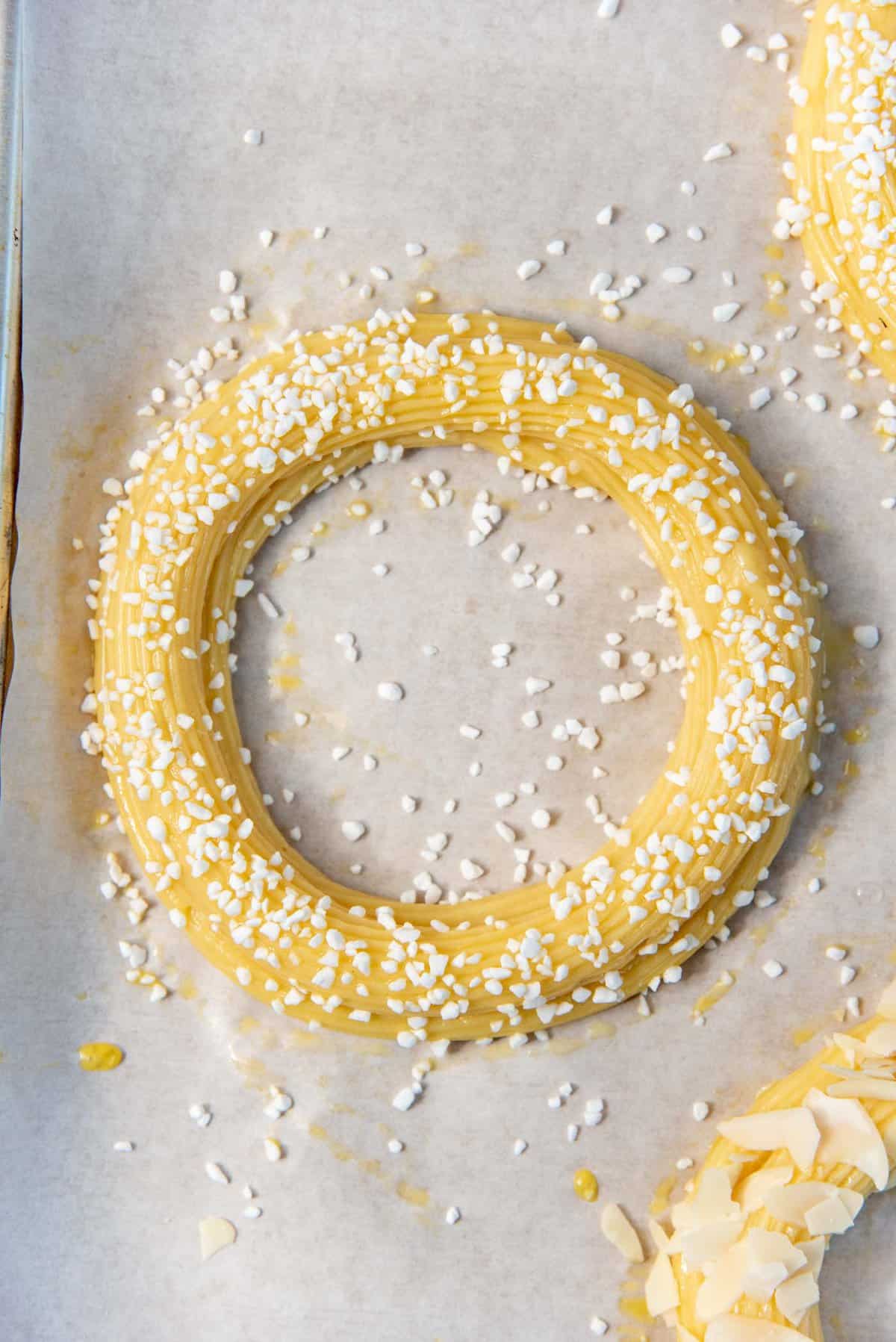

Once ready, put the baking tray in the preheated oven and bake for a total of 35 – 40 minutes. Rotate the pan at the 20 minute mark – if your oven requires this. And then 5 minutes before the pastries are done, quickly open the oven door and prick the pastry ring with a tooth pick all around, and return to the oven for the last few minutes of baking.
This will allow any excess steam to escape from the pastry, and allows the inside to slightly dry out as well. This will ensure that your Paris Brest does not collapse!
Once baked, remove from the oven and prick the pastries again. And let them cool on a wire rack, until you’re ready to fill the pastries.

How to make praline
Traditionally, praline paste is made by caramelizing sugar and then mixing nuts with the sugar until it crystalizes and coats the nuts. Once the nuts are coated with caramelized sugar, they are are blended until a smooth paste is formed.
However, I make this process easier for beginners! Rather than having to mix the nuts in caramel, I break the recipe into two parts. I make the caramel separately, and then roast the nuts separately.
The caramel is made using the dry caramel method. This is when the sugar is placed in a dry skillet and heated with no added liquid. The sugar granules melt and then turn into caramel. This is my preferred method, but it does happen fairly quickly. The caramel is then poured onto a heat-safe surface, lined with parchment paper, and allowed to harden.
The nuts are also placed on a baking tray and roasted in an oven until lightly toasted.
Finally, I place both components in a food processor and blend until I have a smooth praline paste!
The detailed steps for how to make the praline paste, and the different stages in making praline paste can be found in my post – easy praline paste recipe.
You can choose to either make hazelnut praline paste or almond praline paste. You can also use a combination of both.
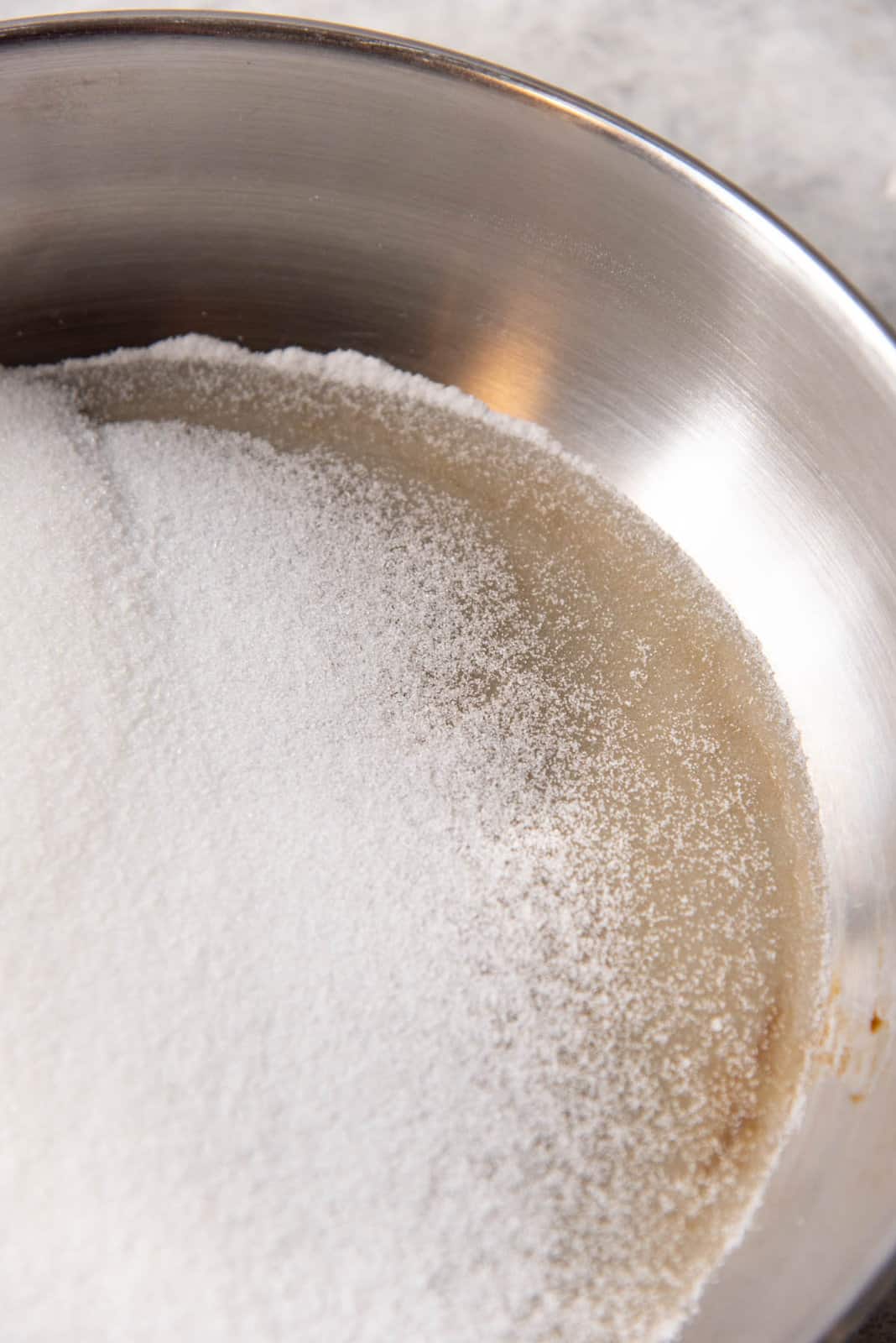

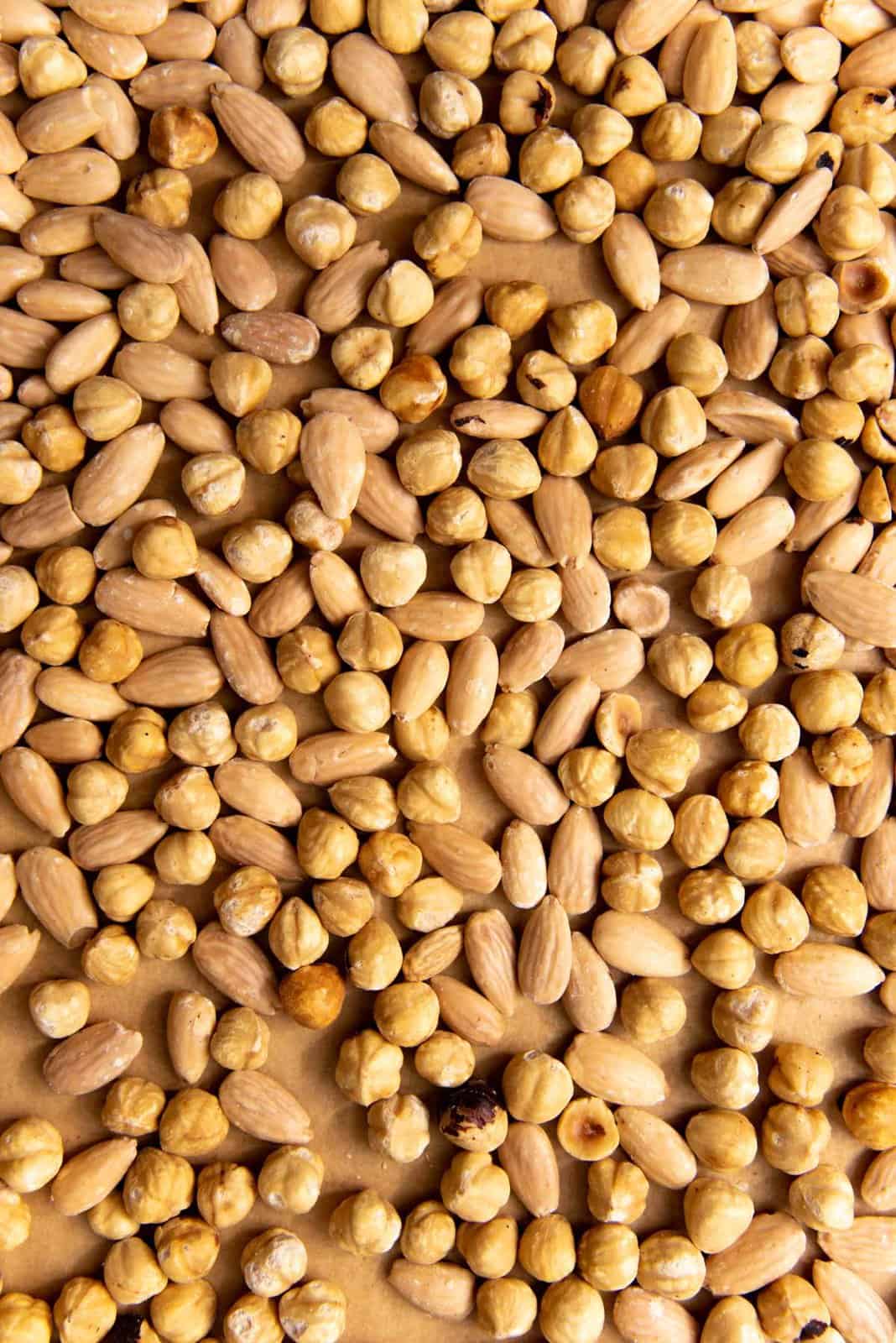

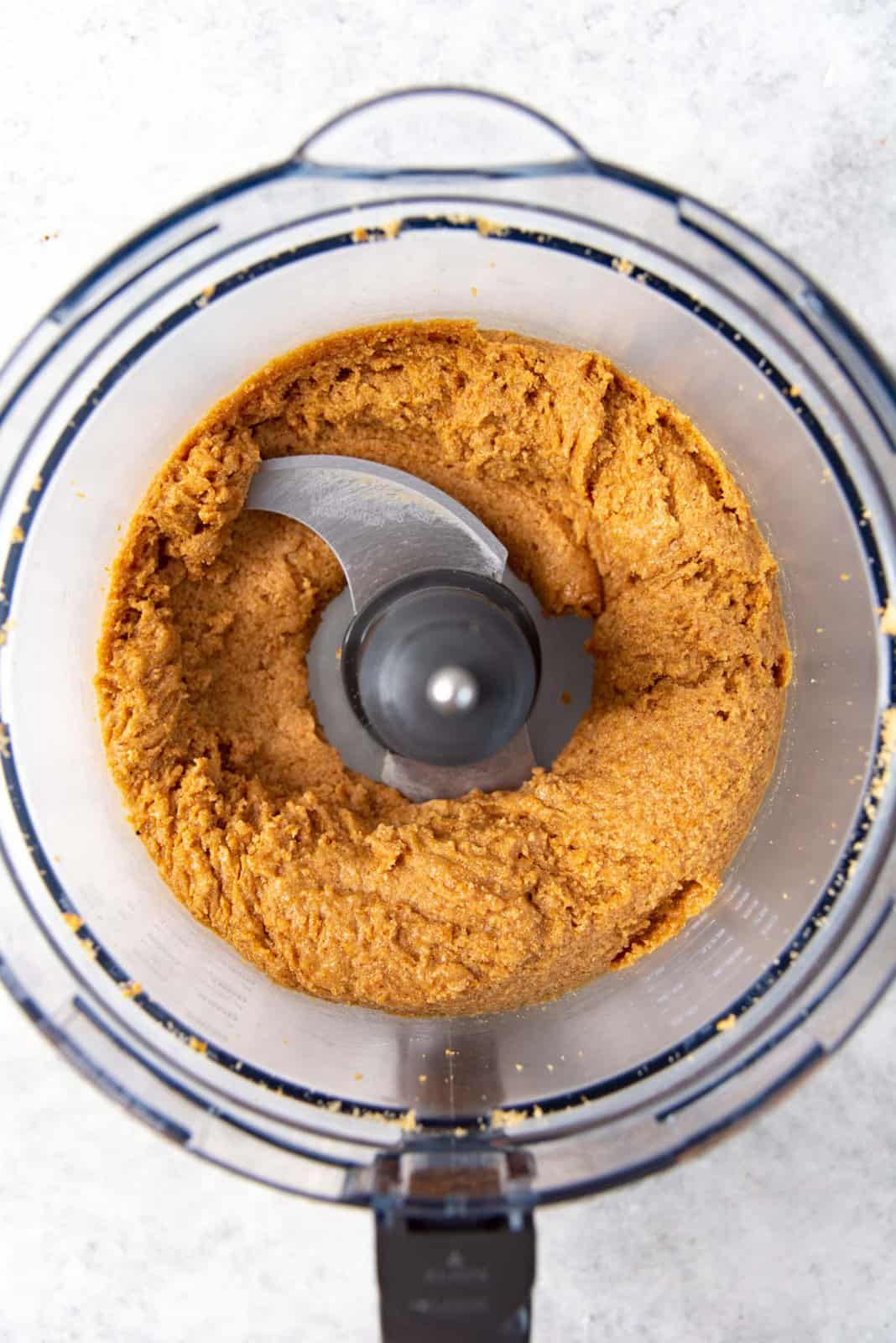
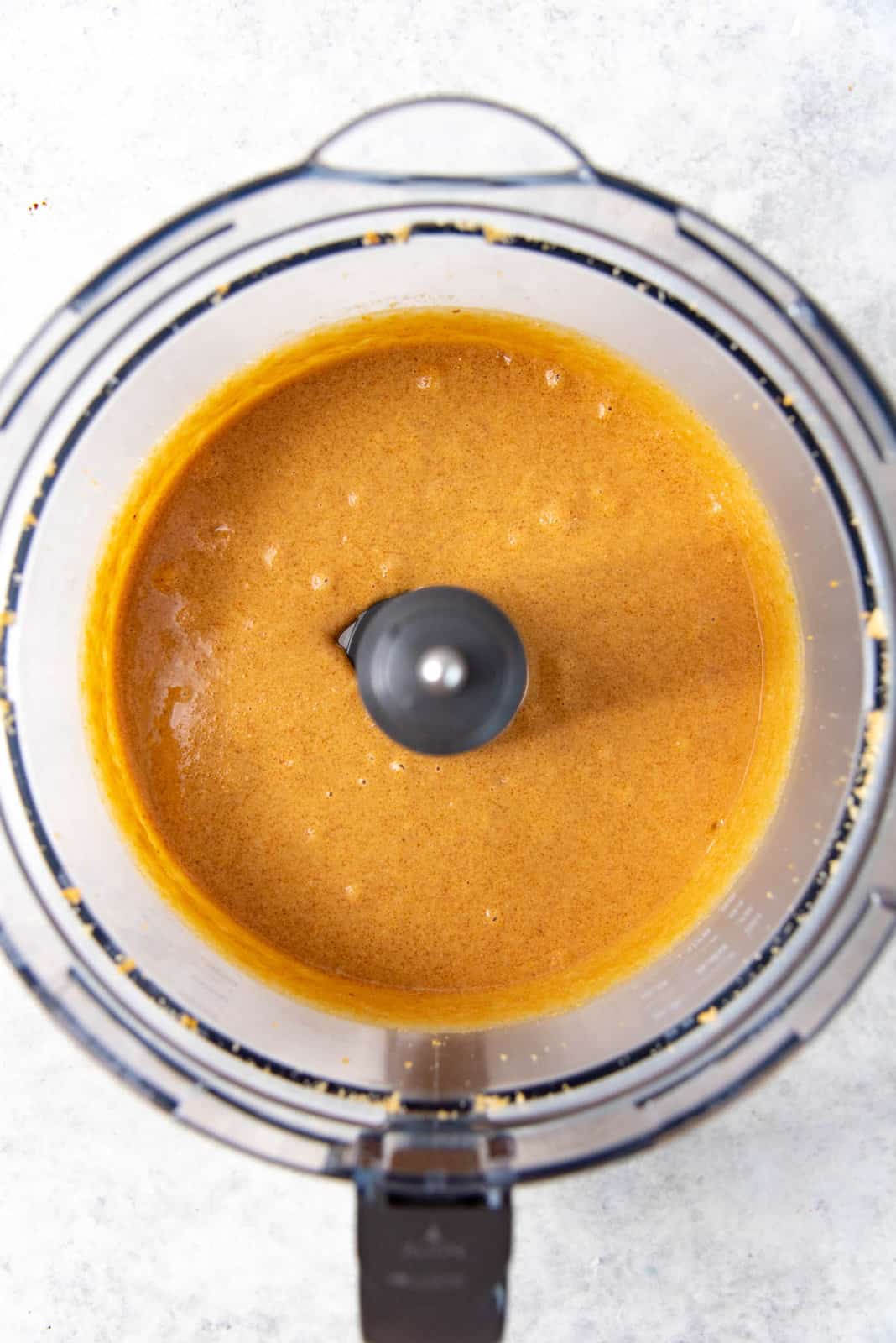
How to make mousseline cream
The traditional filling for Paris-Brest is a praline crème mousseline. Mousseline cream is a type of filling that is made with pastry cream. Thickened pastry cream is whipped with butter to create a rich, creamy, light, and melt in your mouth, delicious filling!
It’s very similar to German buttercream, but a little more dense and creamy. This is because mousseline cream has less butter and less air is whipped into the butter as well. I have an entire post that I dedicated to all the types of custard based creams, and another recipe on how to make classic mousseline cream with or without praline, that you can peruse for this paris brest recipe.
Making pastry cream
The first step for making mousseline cream is to make the pastry cream. With my comprehensive recipe for making the best pastry cream, you’ll be guaranteed perfect results, every time!
The first step is to heat the milk in a saucepan until it starts to steam.
In a separate bowl, whisk together the egg yolks, sugar, salt, cornstarch, and vanilla until you have a thick, smooth, pale-colored paste.
When the milk is heated, remove it from the heat. This hot egg mixture will be used to temper the eggs (i.e. to slowly increase the temperature of the egg mixture), to prevent the eggs from cooking and curdling. Carefully add about 1/2 of the hot milk into the egg mixture, in small amounts, while constantly whisking the egg mixture. Once the egg mixture is very warm, pour this back into the saucepan with the remaining hot milk and whisk well to combine.
Return this to the stove and cook over medium heat while constantly whisking. The custard mixture will start to thicken pretty quickly, so make sure to whisk it well to prevent the eggs from curdling. If the custard is thickening too fast and creating lumps, remove the pot from the heat to whisk well, and lower the heat, and start cooking again.
When the custard starts to boil (large bubbles break the surface), cook the pastry cream for a further 1 – 2 minutes while whisking. The custard is now cooked!
Add half of the butter and whisk to melt and incorporate. Pass the mixture through a sieve and place it in an airtight container. Make sure to place a plastic wrap over the surface of the custard. Let it cool to room temperature and then store overnight in the fridge.
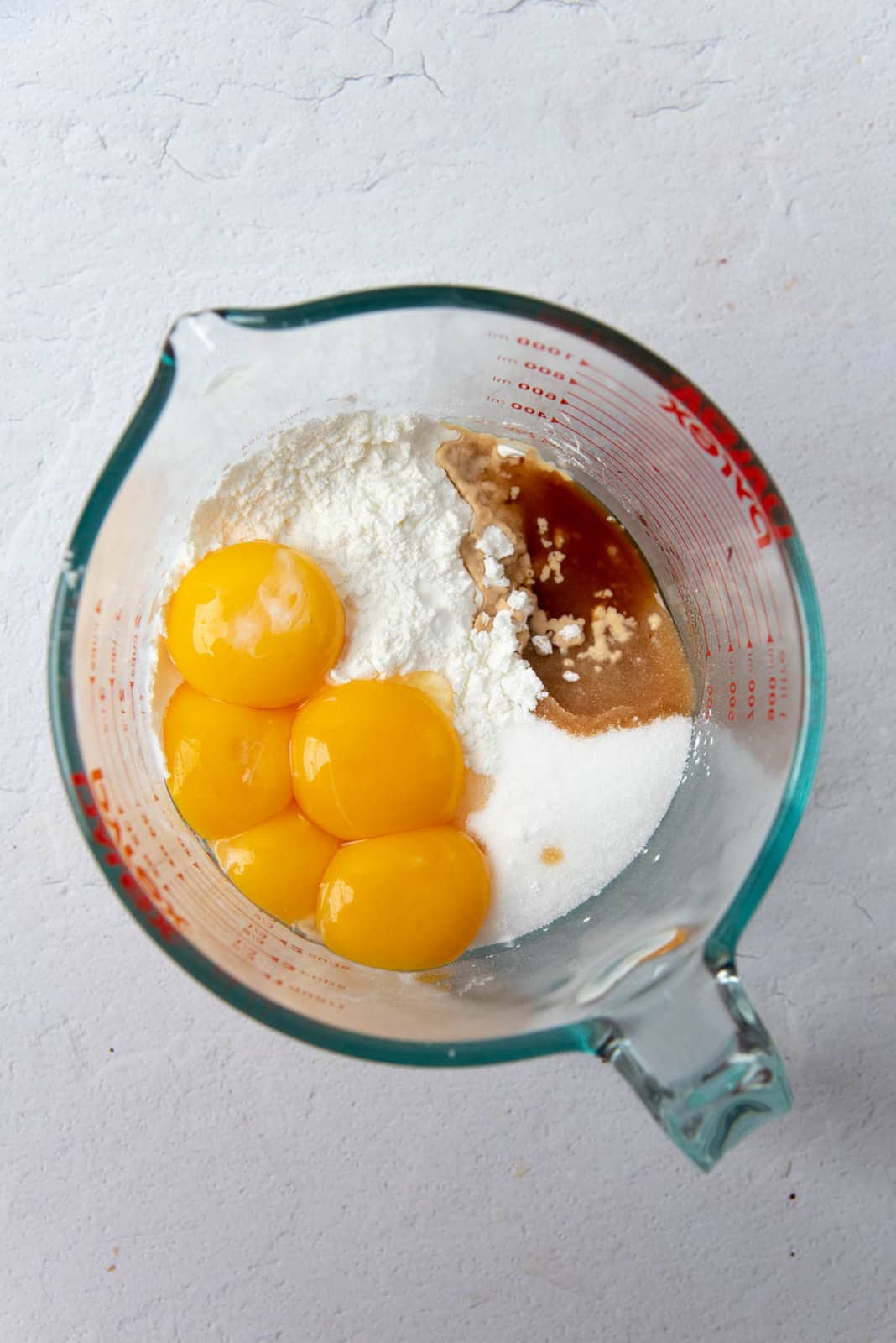



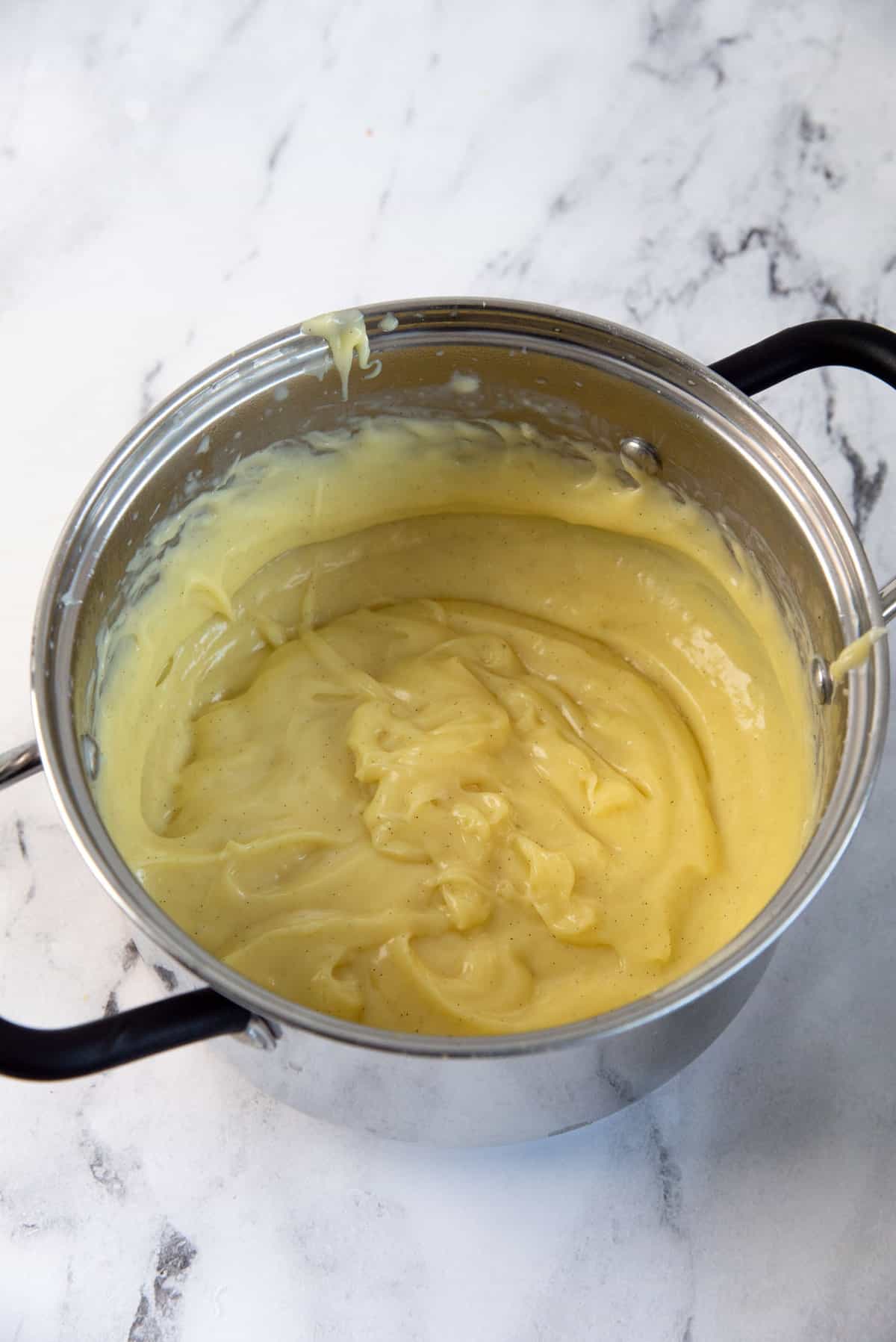
Making praline mousseline cream
Allow the pastry cream to warm up to room temperature so that it’ll mix in more smoothly. You can also place the custard in a bowl and whisk it very well until it’s smooth.
In the bowl of a stand mixer, place the softened butter and praline. Mix until well combined. Whisk for a few minutes until the butter becomes creamy. Then add the custard, a tablespoon at a time, while still mixing the butter praline mix. Make sure the custard mixes in well, without any lumps.
The mousseline cream should be more creamy than airy. Make sure not to whip it for too long, otherwise the cream will have more of a buttercream texture.
For a more detailed and informative post, check my classic mousseline recipe.


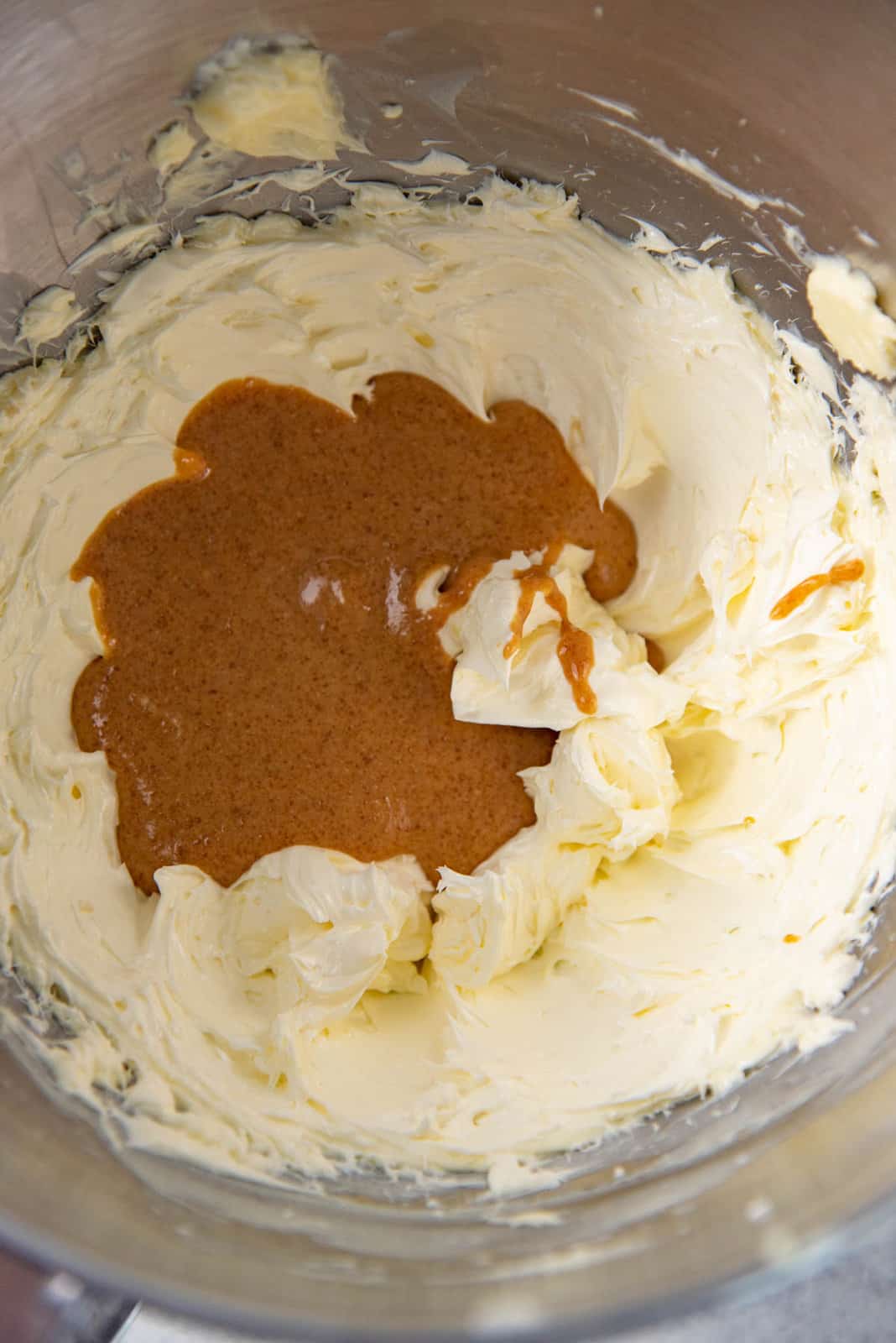
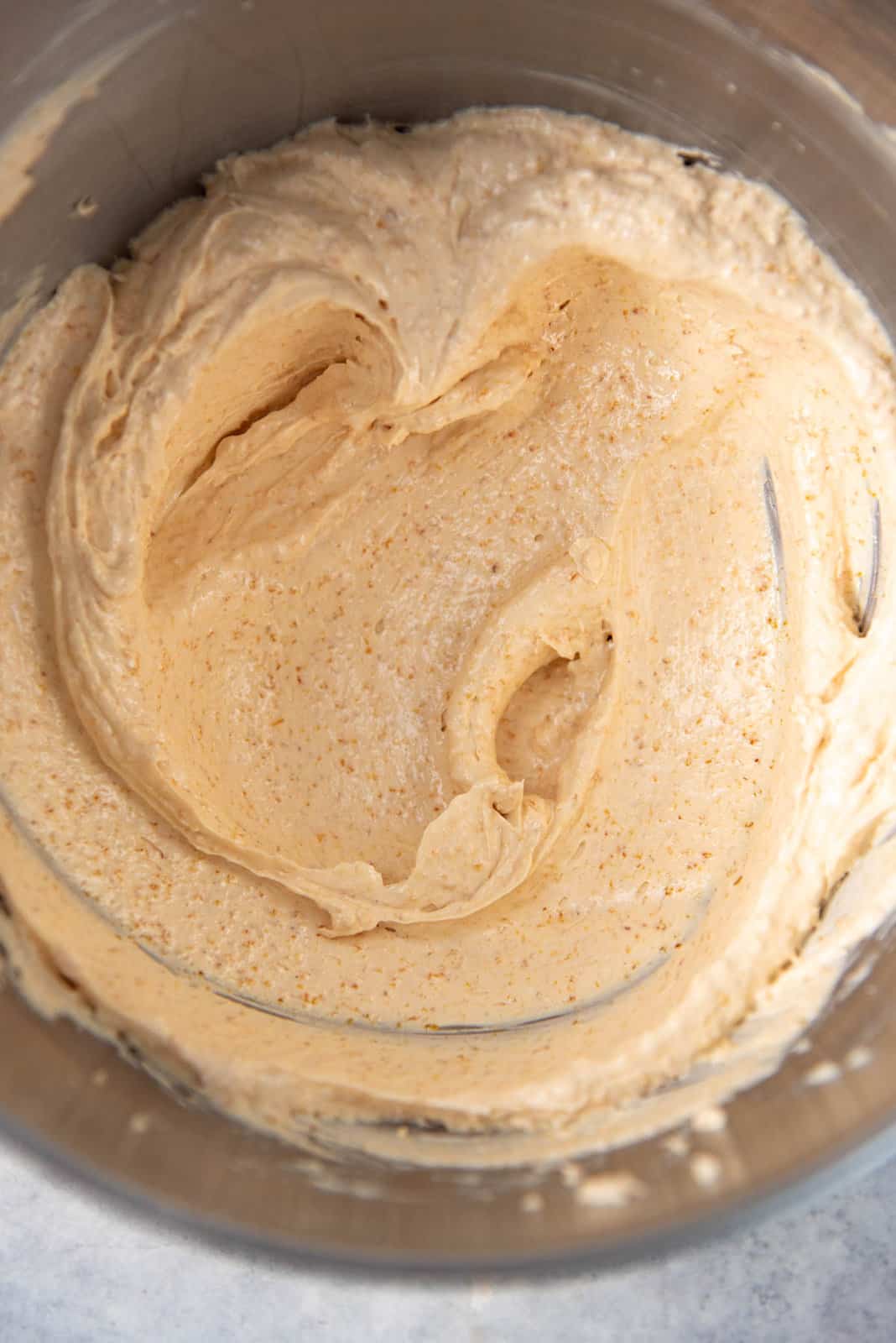
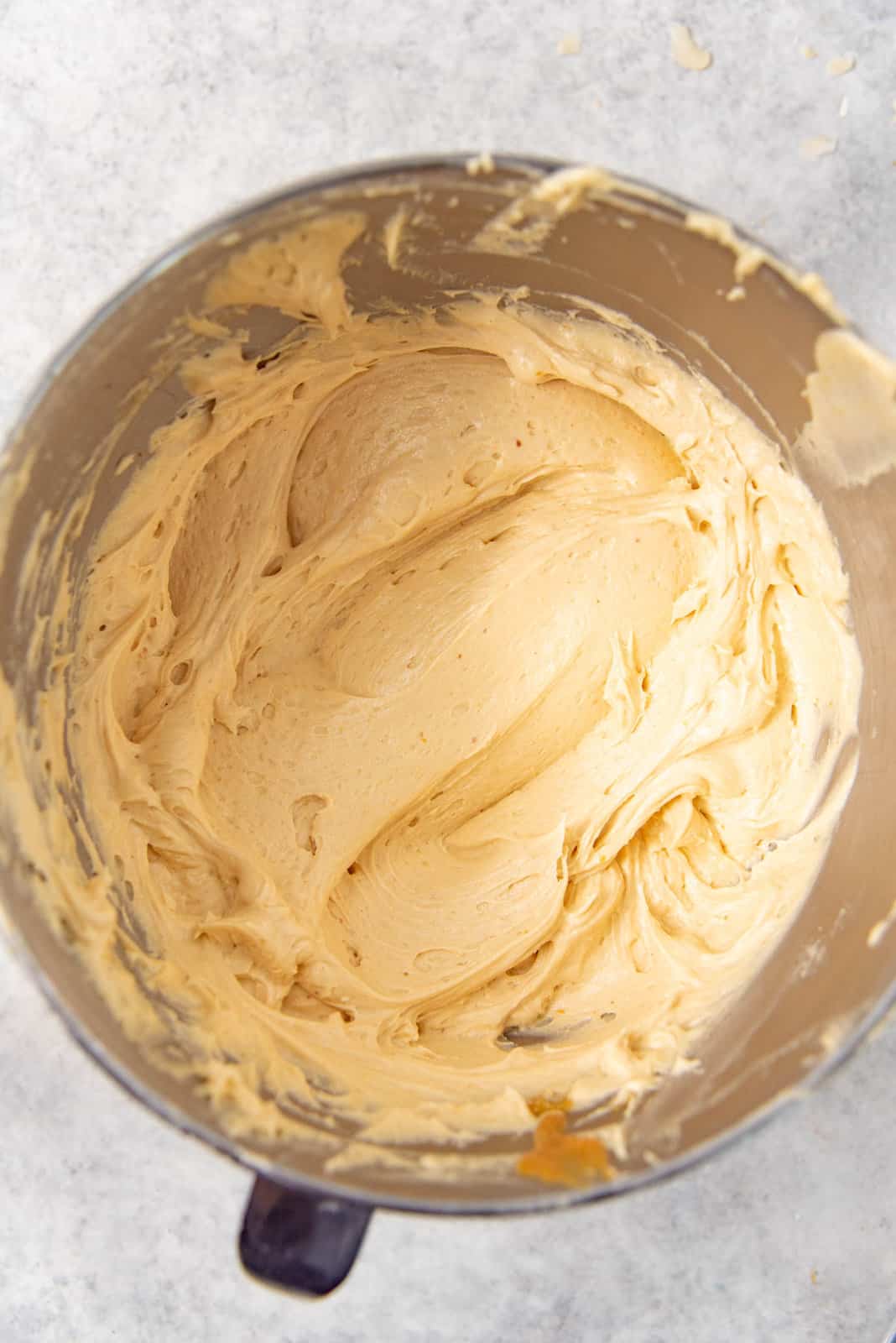
How to assemble Paris Brest
Now that we have all the components of Paris-Brest ready, we can assemble it.
First step – Prepare the pastry
Once your choux pastry is baked and cooled, slice the top off of the pastry. We will only be slicing the upper 1/3 of the pastry. Use a serrated knife and cut the upper part of the pastry as smoothly and evenly as possible, in one piece. Keep this aside until the end.
The inside of the pastry will have dough webbings (see picture below). You can remove these and make sure the pastry case is hollow. Do the same with the top piece, but it may have less webbings.
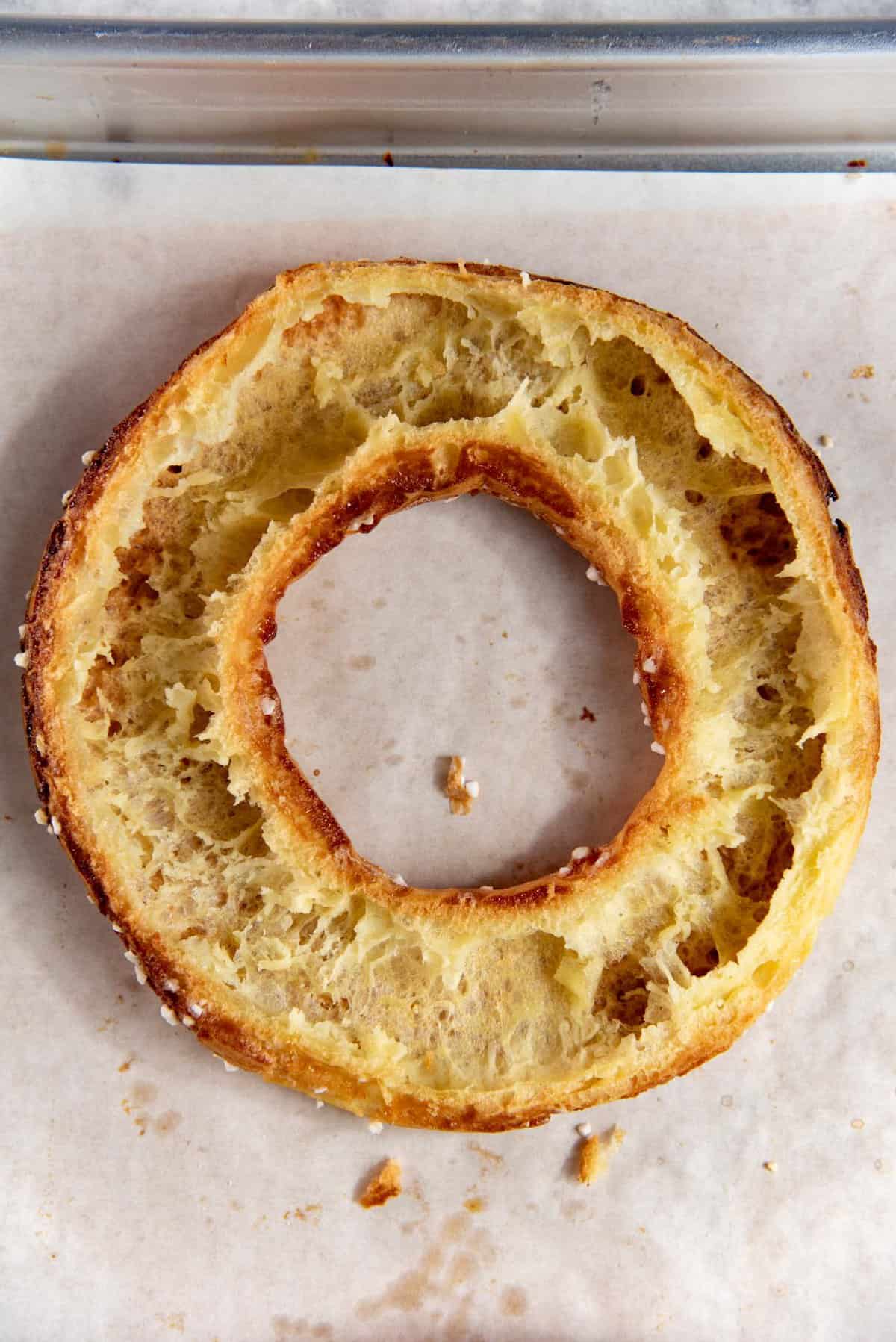
Second step – Prepare the filling
Once you have made the praline mousseline cream for the Paris Brest, scoop the filling inside a large pastry bag. I use a 16 inch or 18 inch pastry bag. Choose a piping tip for the filling as well.
Since the praline mousseline cream will be visible between the layers of the Paris Brest choux pastry, it’s customary to pipe the filling with a decorative tip. I like to use a large open star or closed star tip for this, but you can absolutely use a round plain tip as well.
I prefer to place the piping tip in a separate piping bag, and place the filled piping bag inside. This way, I can change piping tips easily if I wish to.
Step three – Fill the pastry
Paris-Brest is usually overfilled with the filling cream, in order to show a decorative piped filling.
The first step of filling the Paris Brest with the praline mousseline cream is to fill the bottom of the pastry so that it’s easier to pipe the filling in a decorative pattern in the middle (see picture below).

For convenience, I prefer to pipe a line of the filling in the pastry, but you can also change things up and fill it with something different. For example,
- Chocolate ganache
- Chocolate pastry cream
- Praline paste
- Filling and fruits
- Whipped cream
This allows you to add more flavor and textures to your Paris Brest pastry.
Next, pipe the praline mousseline cream into the pastry. Here are some suggestions.
Swirls – You can pipe it in swirls, for an easy decorative pattern.
Blobs – With a plain piping tip, pipe smooth blobs the same way as above.
Rope piping – Use the star tip to pipe a rope border.
Shell piping – Use a star tip to pipe a shell pattern. However, pipe the shell with the wide part facing out, and the thin part facing the inside.

Step four – Finish the pastry
Once you have piped in the praline mousseline cream in the Paris Brest, place the top of the pastry back on the piped cream. You should be able to see about 1 inch of the filling between the two pieces of choux pastry.
Dust the top with icing sugar if you like. Now your paris brest pastry with praline mousseline cream is ready to be served!
Step five – Serving the pastry
Although you pipe the pastry on a 5 inch ring here, the pastry will expand as it bakes. The final size of the pastry is close to about 7 inches.
If you can eat one by yourself, then you ABSOLUTELY should! 😀 It’s utterly delicious, rich decadence with every bite!
However, I do recommend sharing the love with others too. Use a serrated knife and cut the Paris-Brest pastry into sections, like a cake. Then you can serve this dessert to plenty more people.

Pro tips for making Paris Brest
- Get the choux pastry dough right. Most people fail at this very first (and most fundamental) step because their choux pastry turns out to be flat and deflated because they added too much egg. Follow my tips to get the best and most consistent choux pastry results, which include how to know what your dough should look like for perfect pastry shells.
- Use the right piping tips. The combination of the two thicknesses will give your paris brest pastry an excellent puff and stability.
- For the bottom two rings, use a piping tip with a diameter of about 0.35 – 0.4 inches (8.5 mm – 10 mm).
- For the top ring of dough, use a piping tip with a diameter of about 0.5 – 0.6 inches (12.7 mm – 15.2 mm).
- Prick the choux pastry case in the last 5 minutes of baking, so that the steam can escape from inside the pastry, and dry it out a bit. This prevents the pastry from collapsing.
- When you’re making pastry cream, make sure to continuously whisk the pastry cream to prevent the eggs from curdling. The corn starch will also help with this, but the custard must be agitated well to prevent it from setting and forming clumps as well. If the custard is cooking too fast, then remove it from the heat and whisk to evenly distribute the heat, and lower the heat of the stove as well.
- Whisk and cook the custard for at least 45 seconds AFTER it comes to a boil (bubbles breaking the surface). This is because the cornstarch must be boiled so that it’ll be activated and thicken the cream.
- Use a good food processor to make the praline paste, if you want to make homemade praline paste. However, you can also easily purchase this from the store.
- Do not whip the mousseline cream for too long, as it will become more airy. This isn’t necessarily a bad thing. However, mousseline cream is not supposed to be as airy as buttercream. It has a more dense, creamy texture.
- Bake one tray at a time in a conventional or convection home oven. If you bake two trays at a time, there is a great chance that either of the batches will not come out well.
- Use a serrated knife to evenly cut/slice the choux pastry when you’re assembling the paris brest.
Variations
While the classic Paris Brest pastry is filled with praline mousseline cream, you don’t have to be limited by this to make different variations.
You can flavor your mousseline cream with,
- Chocolate,
- Coffee,
- Fruits,
Add other flavors in addition to the filling such as,
- Fresh fruits,
- Praline powder,
- Ganache
- Honeycomb candy
- Freeze dried fruit powder
- Salted caramel sauce
You can also change the filling altogether and substitute it with,
- Stabilized whipped cream
- Pastry cream (vanilla or chocolate)
- Diplomat cream
- Whipped ganache
Profiterole Paris Brest ring
Another variation of Paris Brest is to make a ring of pâte à choux where you make choux pastry profiteroles or cream puffs, and then stick them together in a ring shape. In the picture below, I filled 7 choux pastry puffs with the praline mousseline cream, and dipped each of the tops in caramel. Then connected them with caramel to create a ring shape.
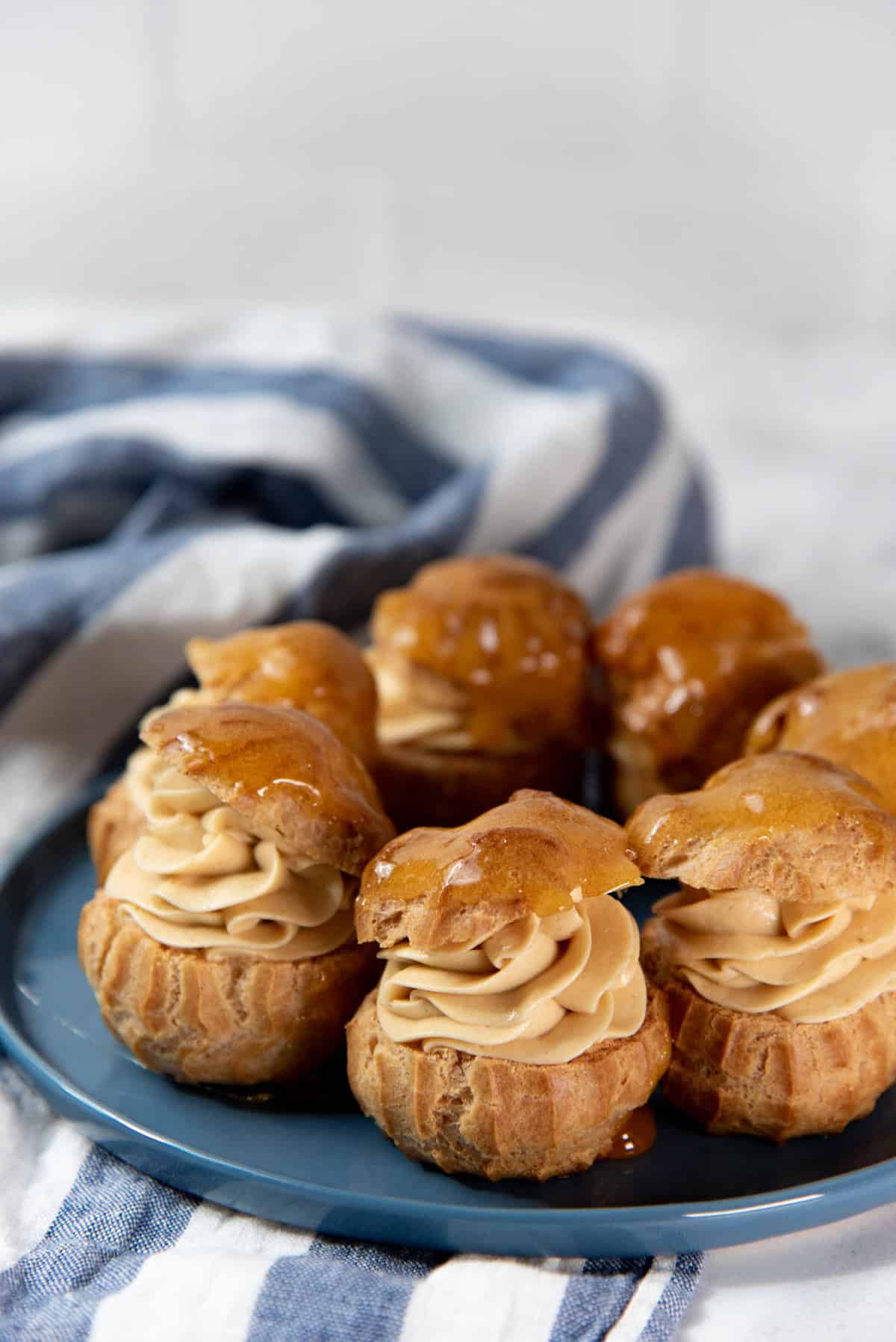
Frequently asked questions
Choux pastry doesn’t rise properly for several different reasons. You may be experiencing one or a combination of these issues.
Too much liquid in the dough – Either the dough wasn’t cooked long enough before adding eggs, or you added too much egg.
The choux pastry was not cooked through and collapsed after baking – Your oven heat was too low, or your pastry required more time to bake.
If the pastry dough was piped too thick, it can puff up unevenly as it bakes. Especially with the bottom two rings. The lower layer of pastry will rise too much, and push the upper ring off center, creating a misshapen ring.
Unfortunately, if your pastry cream curdled a lot, it cannot be fixed. The pastry cream will have a grainy texture even after passing it through a sieve.
However, there are many tips you can follow to prevent your custard from curdling.
Yes, you can leave it out. But it certainly adds flavor to the mousseline cream. You can add other flavors such as coffee or chocolate to the mousseline cream.
However, you can also easily substitute praline paste with nut butters too. It’s not 100% identical because the sugar is not caramelized, and the nuts are not usually roasted, but it’ll still work.
For every 100 g of praline paste, substitute with
65 g 100% nut butter, such as peanut butter or almond butter or hazelnut butter,
AND add 35 g of extra sugar to your pastry cream.
You can definitely make the components of this dessert separately, in advance. But once assembled, it should be served within a day.
Choux pastry dough – Can be made 1 day in advance and stored in the fridge, ideally in a sealed pastry bag. Allow it to come to room temperature before you pipe it to make Paris Brest pastries.
Baked, unfilled choux pastry rings – Baked and unfilled pastry cases can be stored for 1 – 2 days in the fridge. But up to 1 month in the freezer. Place the thawed pastry cases on a baking tray and bake at 300 F for a few minutes to “re-crisp” the shells. This will make them taste a little better, as choux pastry does become stale quickly.
Praline paste – Praline paste will last in the fridge for a few months. So you can make this in advance. It’ll last for at least 1 year in the freezer as well.
Pastry cream – Pastry cream will only last 3 – 4 days in the fridge. I do not recommend freezing pastry cream.
Praline mousseline cream – Mousseline cream prepared with freshly made pastry cream will also only last 3 – 4 days in the fridge. If the pastry cream was made a couple days before, this will also shorten the lifespan of the mousseline cream. Allow the mousseline cream to soften to room temperature and re-whip for a few minutes to make sure it’s creamy before you use it.
You can find out how to pronounce the name Paris-Brest in French here.
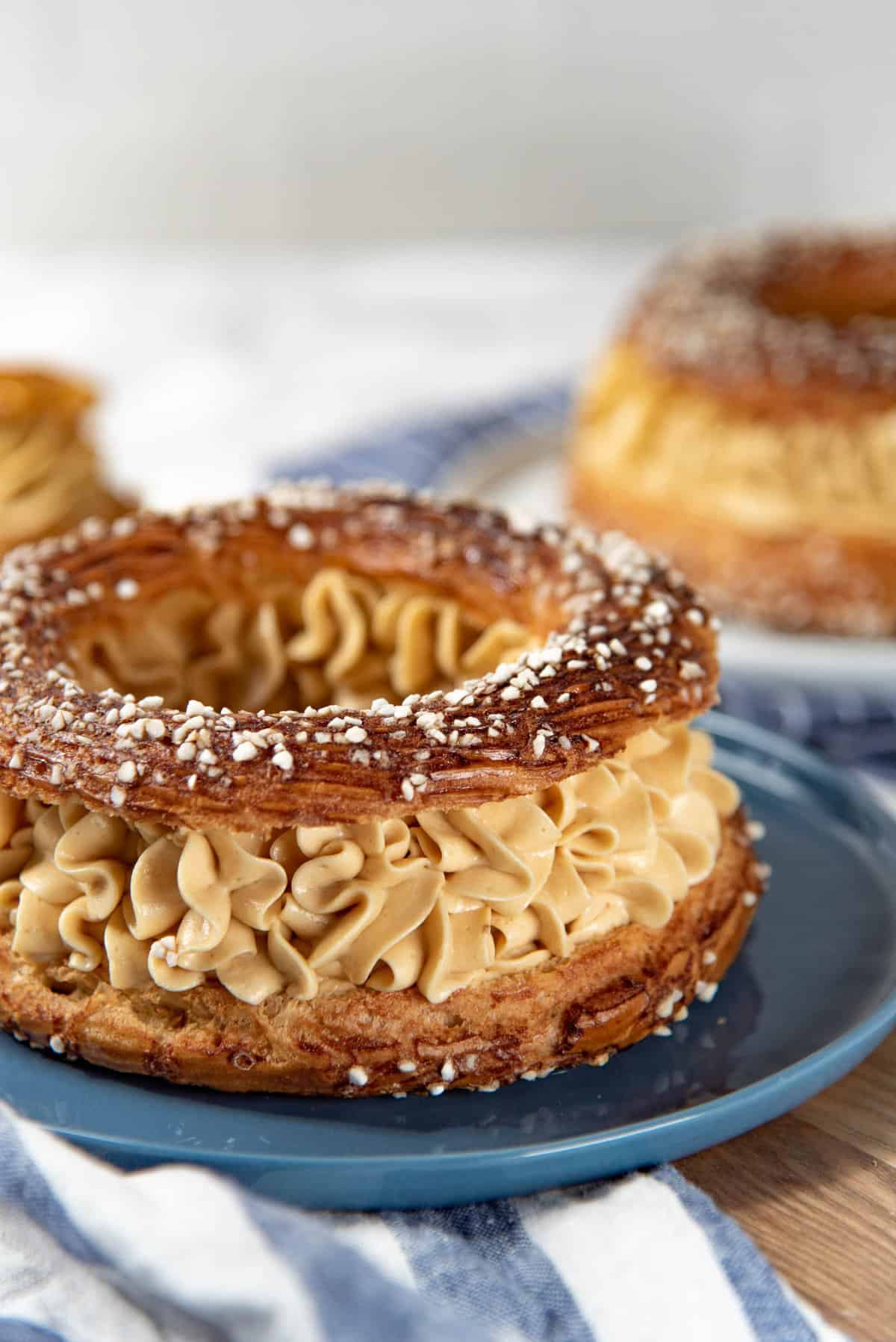
Storage instructions
Paris brest pastry tastes best the day it’s made. Choux pastry is usually crisp straight out of the oven, but loses the crispness as it cools down. However, it still has a sturdy case that is not soggy. Since the pastry is delicate, it does become stale within a day or two.
Once the choux pastry is filled however, the filling will make the choux pastry soggy and make it taste stale as well.
I recommend making Paris Brest the day that you want to serve it for the best taste. However, you can store leftovers for a later date.
FRIDGE – Store in an airtight container and then in the fridge for no more than 3 days. The pastry will taste stale the longer you keep it.
FREEZER – Store in an airtight container and then in the freezer for up to 1 month. This is what I prefer to do. Thaw out only what you need, at room temperature, for a few hours. The pastry will not be as fresh as freshly assembled Paris-Brest, but it’s the best way to store this pastry.
Looking for more recipes?Sign up for my free recipe newsletter to get new recipes in your inbox each week! Find me sharing more inspiration on Pinterest and Instagram.
Paris Brest Recipe with Praline Mousseline Cream
What You Need:
- Hand mixer or stand mixer (for the dough and mousseline cream)
- 5 16 inch piping bags
- 1 Ateco French tip – 863 (or equivalent French star tip / plain round tip that is about 0.3 – 0.4 mm in diameter)
- 1 Ateco French tip – 865 or 866 (or equivalent French star tip / plain round tip that is about 0.5 – 0.6 mm in diameter)
- 2 half sheet baking sheet
- Parchment paper (or silpat)
- Pastry brush
- 1 large open star or closed star tip (to pipe the filling)
- serrated knife
Ingredients:
Choux pastry
- 236 g water 1 cup
- 115 g unsalted butter 4 oz / 1 stick, cubed and at room temp.
- 145 g AP flour sifted 5 oz / 1 ⅕ cup (spooned and leveled)
- 226 g eggs about 4 large eggs
- ½ tsp sea salt use less if using table salt or fine salt
- 1 tbsp white sugar
- ½ tsp vanilla extract optional
- 1 egg for egg wash
- Pearl sugar optional (for topping)
- Sliced almonds optional (for topping)
Mousseline cream
- 480 mL full-fat milk 2 cups
- ½ tsp fine sea salt use less if using table salt
- 150 g white sugar ¾ cup
- 5 egg yolks from large eggs
- 50 g cornstarch 5 tbsp
- 1 tbsp vanilla extract or vanilla bean paste
- 300 g unsalted butter about 21 – 22 tbsp / 10.5 oz (softened and divided into two portions)
- 100 g praline paste homemade recipe or store-bought
Instructions:
Choux pastry
- Preheat the oven to 375°F / 190°C.
- Place the salt, water, sugar, butter, and vanilla extract (if using) in a saucepan and heat over medium heat, stirring occasionally. When the water just starts to boil well (butter should be melted at this point), remove the saucepan from the heat.236 g water, 115 g unsalted butter, ½ tsp sea salt, 1 tbsp white sugar, ½ tsp vanilla extract
- Immediately add the flour (in one go) and vigorously mix the flour in, so that it absorbs all of the water (use a wooden spoon or spatula to do this). When the flour has absorbed the water and it's forming a dough, return the pan to the stove (on medium heat).145 g AP flour
- Cook the dough for a few minutes over medium heat while you mix and knead the dough with the spatula in the pan until you get a dough that pulls away from the sides of the pan. If you use a stainless steel pot, the dough will form a film on the bottom of the pan. The dough should have a thick, mashed potato-like consistency.
- Transfer the dough to a bowl and let it cool down slightly for a few minutes. You can also place the dough in a mixer bowl and mix it with a paddle attachment for about 1 – 2 minutes to cool it down (on low speed).
- Whisk the eggs in a separate bowl.226 g eggs
- With a hand-held mixer (or whisk), mix the dough while adding the eggs, a little at a time. You can also do this with a stand mixer, especially if you make a double batch of dough.
- Mix the dough well after each addition of eggs.
- Only add enough eggs to get a dough with a glossy sheen and a thick pipeable consistency that will hold its shape. You may not add all of the eggs, as I only usually need to add about 3.5 eggs for this amount of dough.
- Once the dough is prepared, put it in an airtight container, and place a plastic wrap on top to cover the dough well. Otherwise the dough will form a skin on top which can interfere with how smoothly the dough will pipe. I prefer to place the dough in a piping bag without cutting the tip, and then twisting the bag close to keep the dough sealed until I need to use it.
Piping the pastry rings for Paris-Brest
- Take a parchment paper that will fit on a half sheet baking tray, and draw three 5-inch circles on it using a pencil.
- Either place this parchment paper upside down on the baking tray, OR place a second parchment paper on top of the first one. Make sure you can see the outlined circles, so that you can use them as a guide to pipe the choux pastry dough rings.
- Place a piping tip with a small diameter, about 0.3 -0.4 inches (Ateco French tip – 863) in a piping bag with the tip snipped off.
- Snip off the tip of the piping bag with the dough and place it inside the piping bag with the tip.
- Pipe a circle of dough just along the outside of one drawn 5 inch circle, with the dough slightly overlapping at the end. Pipe a second ring of dough right next to the first piped circle, on the inside of it. Make sure that the two dough circles are lightly in contact with each other throughout their circumference. Be careful not to pull the dough as you pipe it, or to allow the dough to bunch up either. The dough should have an even thickness throughout as it’s piped out.
- Wet your finger with cold water, and use your damp finger to seal the point of the piped circle where the dough starts and ends. Repeat the piping process with the two other drawn circles.
- Next, swap the small tip for a larger tip with a larger diameter – about 0.5 – 0.6 (Ateco French tip 865 / 866).
- Pipe the dough out through this tip, on top of the two circles of dough. Make sure it lies on top, in between the two piped circles on the bottom. Again, the dough should be evenly thick, and not be stretched out or bunched up.
- Seal the end of the dough by gently tapping on the dough with a damp finger. Repeat with the other two dough circles.
- OPTIONAL – Whisk 1 egg very well. Using a pastry brush, brush a light coating of the egg wash on the surface of the pastry ring.1 egg
- OPTIONAL – Sprinkle pearl sugar on top. Or sliced almonds. Gently press them into the dough, so that they lightly stick to the dough. You can also leave the top of the ring plain without any toppings.Pearl sugar, Sliced almonds
- Transfer the baking tray into the oven and bake for a total time of 35 – 40 minutes. First bake for 20 minutes, and then rotate the tray to bake the pastry the rest of the way. In the last 5 minutes, quickly prick the circle pastries with a toothpick all around (about 5 or 6 pricks each). Then let them bake in the oven for the final 5 minutes.
- The pastries are done baking when they have a dark caramel color on top (with an egg wash), or a dark golden color (without an egg wash).
- Remove from the oven and prick the cases again and let them cool completely on a cooling rack, until ready to assemble.
- Repeat with the remaining dough. Remaining dough can be stored in an airtight container, or a well-covered piping bag. Make sure that the dough isn't exposed to air to prevent a skin from forming on top.
Mousseline cream
Pastry cream
- In a medium-sized saucepan, place the milk, and heat until it’s just about to simmer (or just simmering). The milk does not need to come to a boil.480 mL full-fat milk
- While the milk is heating, in a separate bowl or jug, place the egg yolks, sugar, salt, vanilla, and cornstarch. Whisk very well until the egg yolks start to look a little pale in color and thick, and there are absolutely no lumps in the mixture. Scrape the sides and bottom with a spatula and whisk again to make sure there are no yolk lumps.½ tsp fine sea salt, 150 g white sugar, 5 egg yolks, 50 g cornstarch, 1 tbsp vanilla extract or vanilla bean paste
- When the milk is hot, turn off the stove and remove the milk from the heat.
- Temper the egg mixture by pouring the hot milk into the egg yolk mixture in a SLOW and THIN stream while constantly whisking the egg yolk mixture. This will ensure that the egg mixture gently warms up without turning into scrambled eggs. You'll only need to add about 1 – 1 ½ cups of the milk mixture to temper the eggs.
- Once the egg mixture is tempered, add the tempered egg mix back into the pot with the rest of the milk, whisk to mix, and return it back to the stove.
- Heat the custard base over medium heat (or medium-low if you’re a beginner) while whisking very frequently. Make sure to use the whisk to scrape the sides, bottom and corners of the pot to ensure that the milk is not “setting” anywhere and forming scrambled eggs.
- The custard will start to thicken. Keep whisking until the custard starts to come to a boil. To check if the custard is boiling, you will need to pause whisking for a few seconds at a time to check if there are any big bubbles breaking the surface.
- When the first few bubbles start to break the surface, keep cooking the custard while constantly whisking very well for about another minute (up to 90 seconds).
- When the custard has finished cooking, remove it from the heat and add about half of the butter (150 g / 10.5 – 11 tbsp).300 g unsalted butter
- Whisk the butter to melt it into the custard and mix it in.
- Once all the butter is mixed into the custard, pass the custard through a sieve into a bowl or container to remove any lumps.
- Place a plastic wrap over the surface of the custard, making sure that the plastic wrap is touching the whole surface of the custard to prevent a skin from forming on top.
- Chill the custard for a few hours or overnight until cold. You can let it cool to room temperature and use it immediately as well.
Praline mousseline cream
Preparing the butter
- If the pastry cream is chilled, allow the pastry cream to come to room temperature – around 70°F / 21°C.
- Place the remaining softened butter in a mixing bowl (150 g / 10.5 – 11 tbsp).300 g unsalted butter
- With a paddle attachment in your stand mixer (or hand-held mixer), whisk the butter until it’s creamy and has absolutely no lumps. Add the praline paste and mix it into the butter mixture.100 g praline paste
Adding the pastry cream
- Add the custard into the butter in spoonfuls while mixing the butter mixture, until all of the custard has been added. If the pastry cream is still cold, it will create lumps and won’t be as smooth, so make sure that the pastry cream is at room temperature before adding it into the butter.
- Scrape down the sides of the bowl periodically while mixing to ensure that all the butter and custard are evenly mixed.
- Mix until you have a smooth, creamy, pipeable mousseline cream.
- If the mixture is too runny, or warms up too much, or it’s very warm in your kitchen – transfer the mousseline cream bowl into the fridge and let it cool down. Then re-whisk it to get a firmer, pipeable cream. Chilling the cream longer and re-whisking it well can give you a fluffier texture.
- If the mousseline cream is too airy, like buttercream, you can make it more dense by taking a portion of the cream (about 1 – 1 ½ cups), and warm it in 10 second intervals in the microwave until it’s just starting to melt (but not completely). Add this back into the mousseline cream and mix it in using a spatula. This should deflate the cream slightly. Repeat if you want to further adjust the texture.
- Use the mousseline cream immediately, or within 1 – 2 days for best results.
Assembling Paris Brest pastries filled with praline mousseline cream
- Take each baked paris brest pastry and slice the upper ⅓ of the pastry using a serrated knife. Make sure to do this carefully, as you want the pastry to be cut evenly, and in one piece.
- Carefully remove any dough webbings that might be present inside the bottom part of the choux pastry, and also the top part. Be careful not to tear the outer pastry case as you do this.
- Place the praline mousseline cream in a pastry bag, with a large open star or closed star tip attached.
- Pipe a thick line of filling on the bottom of the choux pastry ring case, so that the cavity is mostly filled.
- Next, pipe the filling in patterns on top of the previous filling. You can either pipe swirls, or shells, or a rope border (as I've done in the pictures in this post) all along the bottom choux pastry ring.
- The filling should be at least 1 inch tall from the surface of the pastry.
- Place the sliced top part of the pastry on top of the piped filling. Gently press down so that the pastry sticks to the filling.
- Refrigerate for about 1 hour, and then serve.
- OPTIONAL – Dust with confectioner's sugar before serving.
Nutrition Information:
“This website provides approximate nutrition information for convenience and as a courtesy only. Nutrition data is gathered primarily from the USDA Food Composition Database, whenever available, or otherwise other online calculators.”

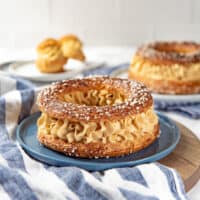
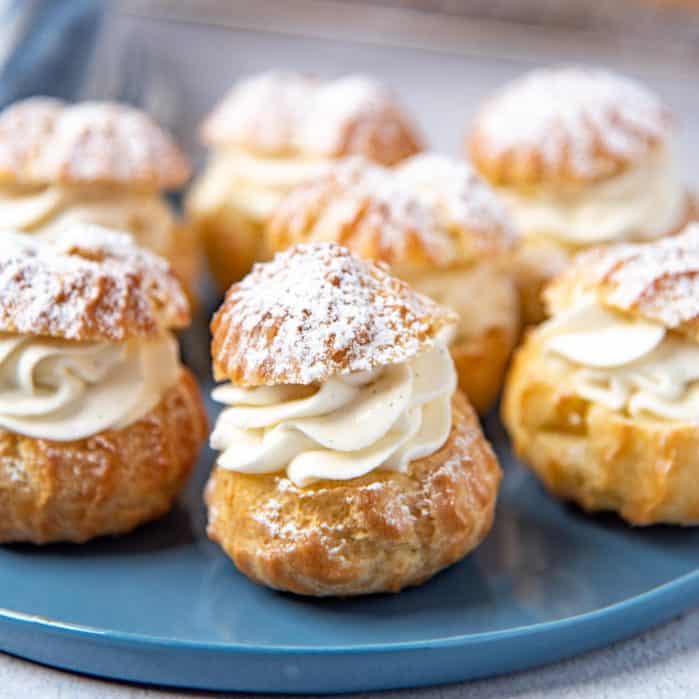
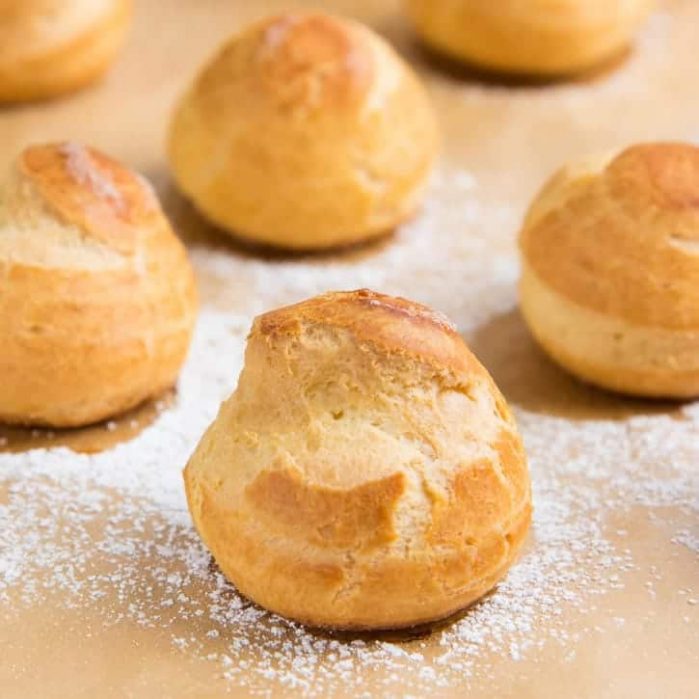
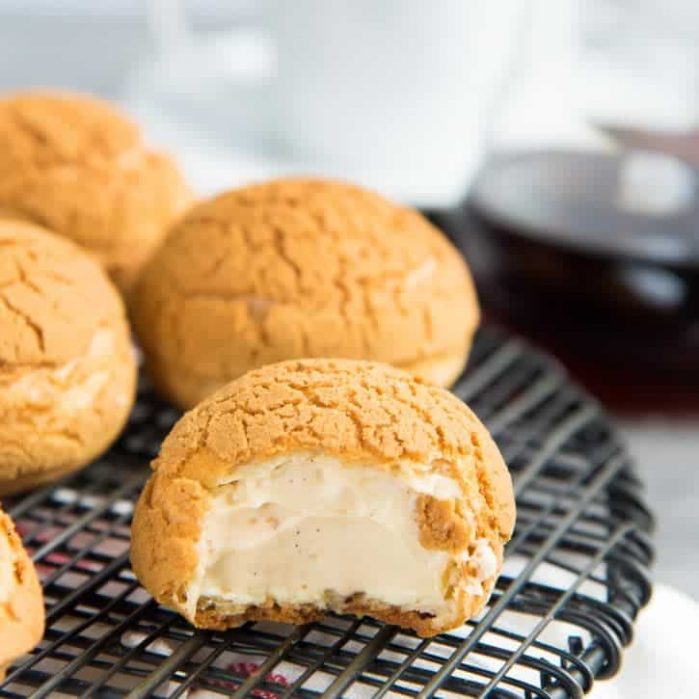
Ally says
How many cups of praline mousseline buttercream does this recipe yield? I would like to use it to frost and decorate (not fill) a 8” four layer cake. Thank you.
Dini says
Hi Ally
It should make about 5 cups. I have the separate recipe for mousseline cream with yield information as well.
Depending on how thick you want the frosting to be, I think 5 cups would be more than enough to frost and decorate an 8 inch 4 layer cake.
I hope that helps!